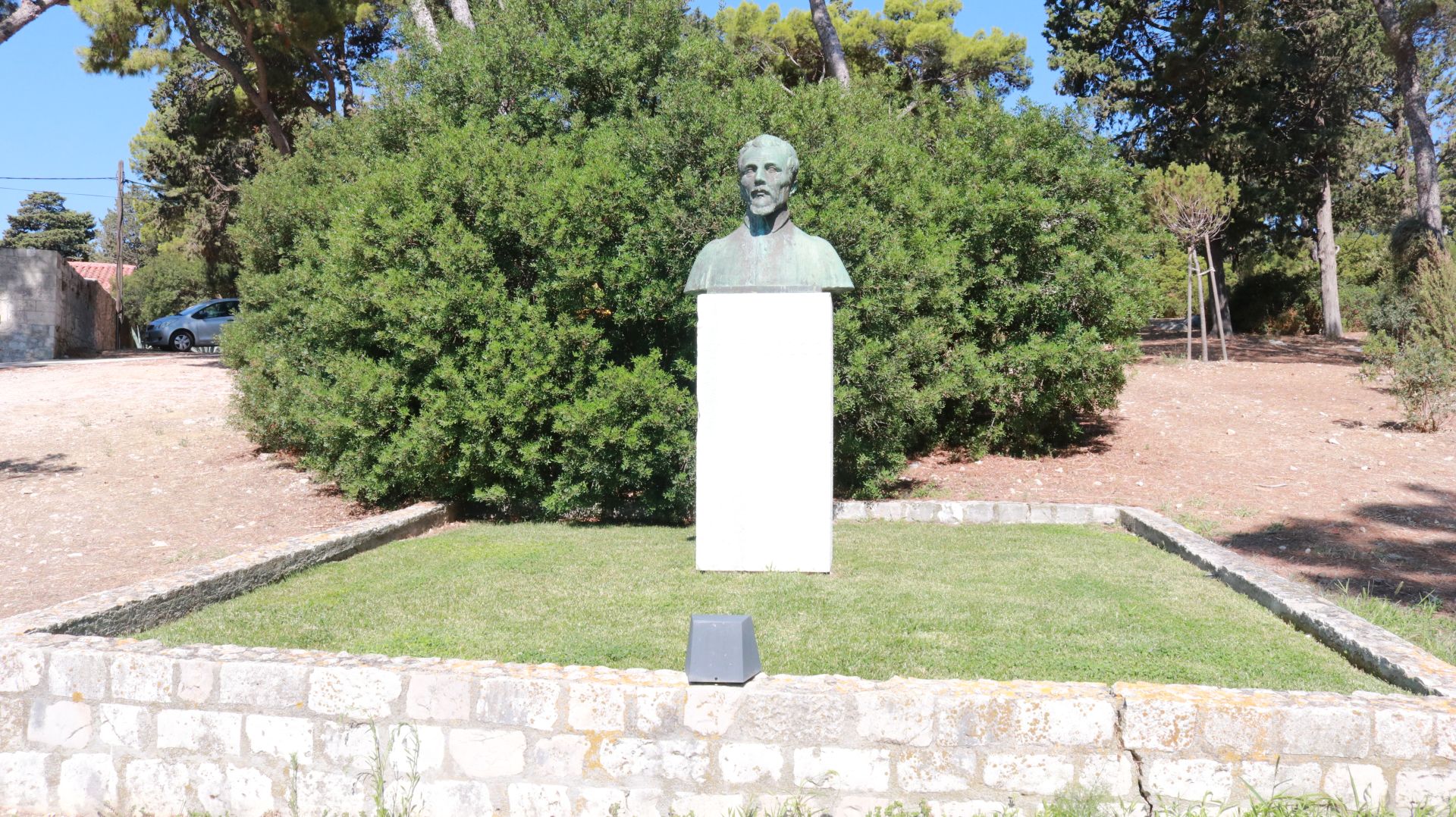Močvara Handcraft Fair: Local Artists Showcasing DIY Work
September 22, 2021 - The Močvara Handcraft Fair organized by Udruga Avokado introduces the public to the handcrafted jewelry, cosmetics, and products of local artists while promoting an alternative, eco-friendly lifestyle.
Močvara nightclub in Zagreb, right on the Sava embankment (with Trnjanski Nasip bb being the address) is known for decades of supporting alternative art and culture, from music (punk-rock, metal, indie, and the most obscure electro-music extravagance), to theater, literature, circus, and more. As TCN wrote a couple of years ago, the venue hosted Žedno-Who pre-Party with a performance of an established Canadian musician Marc Demarco. In recent years Močvara opened more space to handcraft and Do-it-yourself culture (DIY).
In that spirit, the venue hosts a Handcraft Fair this Sunday, September 26, from noon to 6 pm, and the entrance is free of charge.
The event is part of the Močvara Living Room (Močvari Dnevni Boravak) program, happening mostly once to twice a month.
The fair will offer visitors handcraft jewelry, herbal food, drinks, clothes, toys, and cruelty-free cosmetics.
So far, the event's Facebook page has presented five local exhibitors that will showcase and offer their work to the visitors.
Free Goats is a new project with the „aim of visually expressing completely personal perception of everyday observations“. The various themes are united by stylish simplicity, and visitors can see and buy stickers, original drawings, and smaller dimension prints. Most of the work, as the project description points out, is made on recycled paper.
Resin+Metal handcraft jewelry is inspired by the everyday woman (from red lipstick to a girl in cleats).
Tallulah's Workshop is a vintage-inspired female collective making scrunchies and hair bands in various patterns and with floral decorations.
Dangerous Beats, a long-time producer and percussionist, recently shifted to tie-dye T-shirts and alcoholic ink.
Last but not least, Jelena lončarić's handcraft jewelry comes in all sizes, shapes, and colors.
With these five local artists confirmed, the event page points out that participation applications are still open until September 24. Just like the entrance to the event, participating in showcasing your work is also free of charge, but you have to send a mail to This email address is being protected from spambots. You need JavaScript enabled to view it. to apply.
Udruga Avokado Avokado (Avokado Association), promotes a vegan diet and ecological sustainability.
With the aforementioned space for alternative arts and lifestyles, Močvara's Handcraft Fair is one more event that connects local artists with the public and gives space to less conventional expression.
Learn more about Zagreb on our TC page.
For more about culture in Croatia, follow TCN's dedicated page.
Jasmina Krajačić Closeups Exhibition: Questioning Consumerism Through Pop Art Portraits
September 18, 2021 - The Jasmina Krajačić Closeups exhibition looks at our identities and criticises consumerism in a visual dance of colours and geometry. The exhibition can be seen from Sept 23-28 at Galerija Siva in Medika, Zagreb.
Pop Art playfulness filled with colours and details is a recognisable signature of Jasmina Krajačić. This Zagreb-based artist was born on July 26, 1968, and after graduating from the Applied Arts School in Zagreb, she moved to the Zagreb Academy of Fine Arts, where she earned her degree in 1992.
Her contemporary work, which takes an obvious interest in geometry and design, has taken a lot of its influence from England's punk movement and pop culture.
Krajačić's newest exhibition, entitled ''Closeups'', is set to be held at Galerija Siva, and its opening is scheduled for September 23, at 20:00, and the exhibition will last and be available to the public every day apart from Sunday from 17:00-20:00 all the way until September 28. The Jasmina Krajačić Closeups exhibition includes portraits, pop art recycling, and the transformation of original photos. These photos are both of famous people (such as David Bowie, Amy Winehouse, Debbie Harry from the band Blondie, and more), of unknown people and also Krajačić's own self-portrait.

Invitation to the Closeups exhibition © Jasmina Krajačić
Tatjana Bezjak, a Croatian sculptor and writer, wrote a review of Krajačić's work which is going to be featured in the upcoming exhibition. She rated Krajačić's sixteen portraits as playful, attractive, full of colours, and invitingly cheerful. At first, Bezjak points out that these attributes are disturbing, but they bring out calm inside of us when we look at these close-ups and decipher some of the messages behind Krajačić's work ourselves.

David Bowie © Jasmina Krajačić
''Close-ups are a look in the mirror, in the face of contemporary society, a society of consumerism and spectacle, deranged values and identity crises. Close-ups do not differ by the status, success or popularity of those in the portraits. Whether we belong to the anonymous crowd or to the shiny world of fame and celebrities, with commodities and identities, all of us are deceiving ourselves, without exception. While the invisible hand relentlessly serves new needs and practices, moving some final goalpost, some ultimate fulfillment is always further behind the horizon. It is almost impossible not to reach it, again and again“, writes Bezjak.
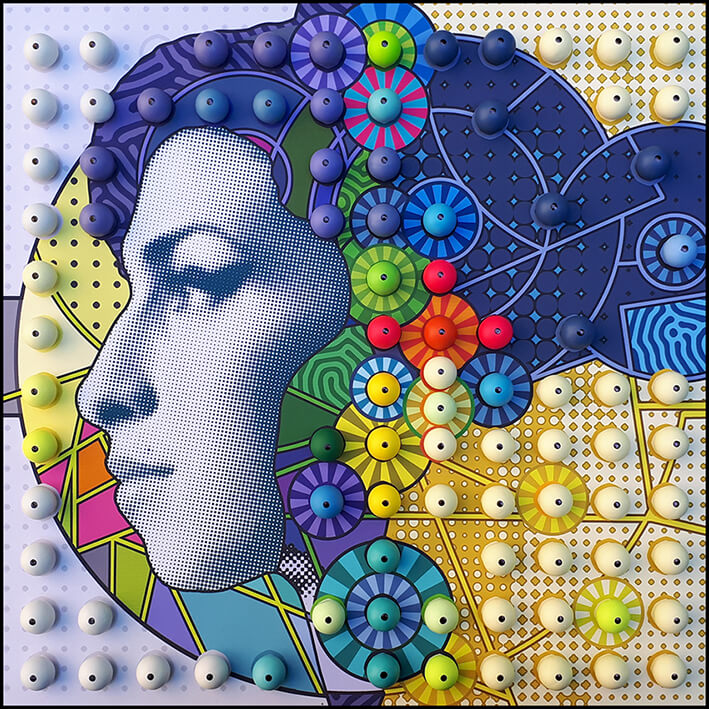
Amy Winehouse © Jasmina Krajačić
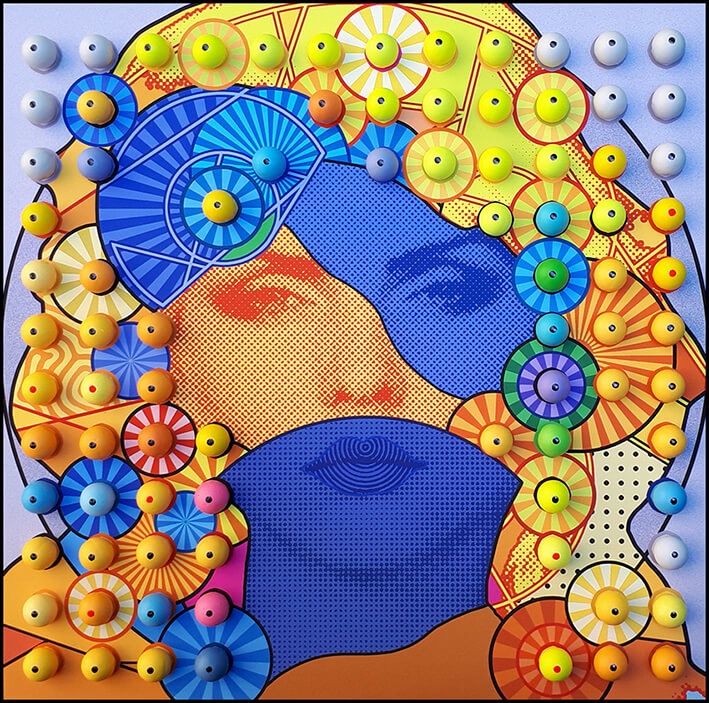
Blondie © Jasmina Krajačić
The criticism of the neo-liberal paradigm and constantly chasing profit consumerism is evident even in the name sof Krajačić's pictures. Titles that will be showcased in the exhibition such as ''Buy Passion'', ''Buy Patience'', ''Buy Empathy'', ''Buy Eternity'', ''Buy Wisdom'', ''Buy Dignity'', ''Buy Fearlessness'', ''Buy Affection'', accompanied by the eye-candy-like geometrical game of circles and colours, constantly force us to challenge our own identities.
The question posed to our identities is not necessarily difficult to answer with a simple yes or no, because of sheer complexity, but rather because it is a question we don't want to answer honestly: Are our identities genuine or bought?
Learn more about Croatian Art Galleries in Zagreb, Dalmatia, Istria & Slavonia on our TC page.
For more about art in Croatia, follow TCN's dedicated page.
Museum Practicum Project: Curator and Art Education by Zagreb Contemporary Art Museum
September 13, 2021 - The Museum Practicum Project by the Museum of Contemporary Art Zagreb (MSU) will teach 30 selected young people aged 15-25 about the professions of curator and other museum jobs, as well as contemporary art while giving them a chance to promote their own work.
With the many good practices of additional education and popularising scientific and educational fields for young people (such as the SCOPE Project by the Višnjan Observatory), the Museum of Contemporary Art (MSU) in Zagreb is also making its contribution in line with their field. Their Museum Practicum project that started on September the 1st and will last until June the 30th, 2022, wants to introduce young people aged 15-25 to contemporary art, and to the basics of curator practices and other types of museum work. Thirty selected people will be mentored by the project team, partners, and hired experts and artists.
''The work with these young people will be held via online platforms, and it will include moderated conversations, mentorships, and co-creating virtual exhibitions from MSU holdings and exhibitions of their own work in the medium of photography created within the project,'' says MSU's website.
In this way, the project wants to provide young people with the opportunity to develop their own creative skills and knowledge through a virtual space and open space for both their expression and self-promotion.
''Even though curriculum reforms have already started, the need for young people interested in developing their social and creative skills is strong, as the education system does not provide that enough. Additionally, there is the insufficiency in regional representation and the limited participation opportunity of young people in art and culture activities due to the lack of extracurricular activities, all of which has been additionally worsened by the COVID-19 pandemic,'' says MSU, addressing the importance of the Museum Practicum Project in light of the many issues faced by Croatian schools.
The further recognition of the importance of the project is evident by the financial support of the EU from the European Social Fund, and the total budget of the project is 201,092.83 kuna.
The Museum Practicum Project and its wider goal of educating young people in preparing virtual exhibitions is similar and in line with the Women and Technology Program at the Nikola Tesla Technical Museum, about which TCN previously wrote. Add in the overall challenges in the Croatian education system, from a lack of extracurricular activities to the previously mentioned problems of the straight A epidemic, and projects like these seem like welcome solutions to help young people recognise their worth and find passion in their lives.
Learn more about Zagreb on our TC page.
For more about education in Croatia, follow TCN's dedicated page.
Ministry of Culture Shortlisted For World Literacy Awards
ZAGREB, 8 Sept, 2021 - The Croatian Ministry of Culture and Media has been shortlisted for the World Literacy Awards in the category "Significant Contribution to Literacy by a Nation" for its "Year of Reading" campaign, and the laureates will be declared on Wednesday evening on World Literacy Day.
The World Literacy Awards are annual recognitions given to valuable initiatives around the world that promote literacy and education, the ministry said on Wednesday.
They are divided into several categories and given to individuals and organisations for their outstanding endeavours that promote literacy. The laureates are selected by a panel of judges consisting of eminent leaders from across the globe, including literacy and literature experts, Nobel Literature Prize recipients, and award-winning authors.
Croatia has one more candidate who has been shortlisted, Prof. Anita Peti-Staničić, who has been nominated in the Academic Award category.
Her work on reading literacy consists of two tiers, both equally important and complement each other. The first is her publishing activity. The second is her activist work on putting reading literacy in the centre of interest of librarians and teachers at all school subjects.
The government declared 2021 The Year of Reading. The declaration of The Year of Reading is part of a measure from the National Strategy to Promote Reading, adopted in 2017.
International Literacy Day is an international observance, celebrated each year on 8 September, declared by UNESCO on 26 October 1966 at the 14th session of UNESCO's General Conference. It was celebrated for the first time in 1967.
For more about politics in Croatia, follow TCN's dedicated page.
KUF Festival 2021: Circus Takes to Zagreb Streets
September 3, 2021 - The KUF Festival 2021 is the third edition of a Cultural Street Festival that brings the circus to the streets of Zagreb. Organised by the Cirkorama collective, you can enjoy the crazy acrobatics, hilarious performances, and more in the following September weekends.
The Cirkorama collective has been known in Croatia for years for promoting the art of circus through various types of education, shows, street performances, and projects. There will certainly be a lot to do while juggling all the events in Zagreb over the September weekends to come.
These events will all be part of the KUF-Cultural Street Festival, which is now in its third edition, and will bring street art performances to all parts of Zagreb, starting this weekend (September 4-5) in Sopot. After that, it will follow with performances in the neighbourhoods of Vrbik (September 11-12), Mažuranac (September 12), Borongaj (September 18-19) and concluding in Vrapče (September 18-19). This is an excellent way to continue on the same path after Zagreb's handful of events in August.
''The Cultural Street Festival is dedicated to street performances, local artists, and the local population. Its goal is to present the art of urban street culture and circus art throughout Zagreb's neighbourhoods. Therefore, the festival this year, just like in the previous ones, will travel to the city's neighbourhoods providing its residents circus-like street shows for all ages,'' said the festival organisers in a press release.
On a mission to enrich the City of Zagreb with cultural content, the ease of hitting the right street to enjoy the show is paired well with ticket-free entertainment.
The founders of Cirkorama are indeed pioneers of circus arts in Croatia, as they were the first to bring juggling and stilt walking to Croatian cities. These forms of entertainment on the streets were soon followed by acrobatics on silk and much more.
Projects promoting the modern circus with partners such as the Red Cross were aces for Cirkorama to show that the joys of the circus aren't only limited to specific locations and inside tents. With circus shenanigans being much more enjoyable than Zagreb's usual traffic accidents, head over to the designated areas to enjoy it this month.
What better way to get hyped for September than by checking out the bit of action in this video:
Learn more about Cirkorama on their Youtube page, featuring performances and a serious discussion on the art of circus.
Learn more about Zagreb on our TC page.
For more about culture in Croatia, follow TCN's dedicated page.
World's Best Naive Art: Authentically Croatian Hlebine School
September 1, 2021 – We visit Podravina to discover the incredible Hlebine School of Croatian Naive Art
Croatia is sometimes difficult to find. Of course, with modern GPS and Croatia's nine international airports, getting here is no problem. But just where are you when you arrive?
Looking down at your dinner, the plate may hold a dish recognisable across the Mediterranean. Above your head, the architecture could be Roman, Austro-Hungarian or modern, indistinguishable. Ottoman influence lies everywhere from the best-loved handheld snacks to the mountain of slippers in every dwelling's doorway.
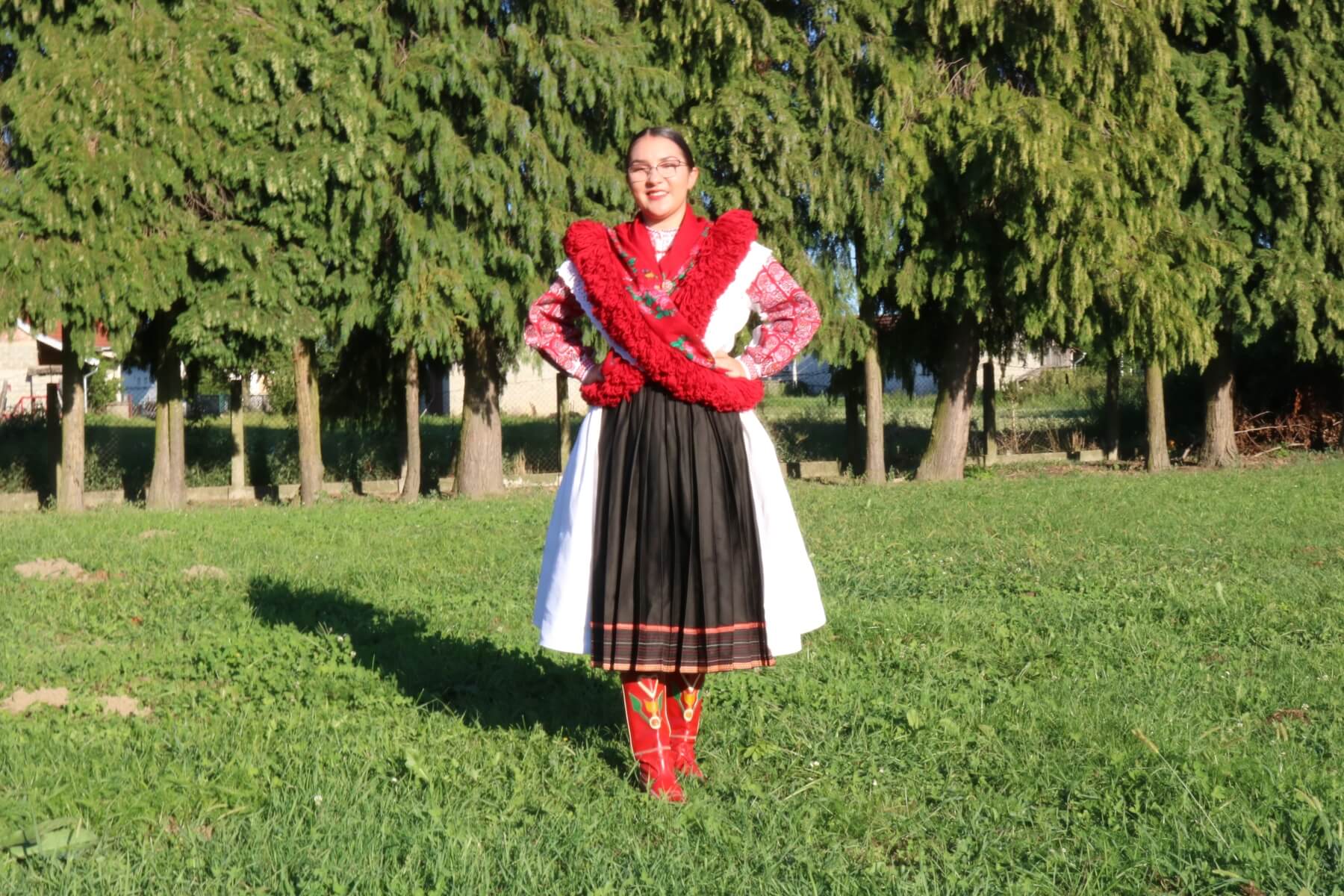 A friendly local wears the folk costume of the small region surrounding Koprivnički Ivanec, near Koprivnica. The costume features the incredibly intricate Ivanečki vez embroidery, which has been safeguarded locally for over 90 years and is now a protected part of Croatia's cultural heritage. Photo © Marc Rowlands.
A friendly local wears the folk costume of the small region surrounding Koprivnički Ivanec, near Koprivnica. The costume features the incredibly intricate Ivanečki vez embroidery, which has been safeguarded locally for over 90 years and is now a protected part of Croatia's cultural heritage. Photo © Marc Rowlands.
Actually, the true essence of the country you'll find in the Croatians themselves. And yet, their history is all too often obscured by the impositions of empires that once were here. However, we can find this history away from the major cities, the centres of influence. We find it in the villages. Specifically, in their folk costume, their folk song and folk dance. And we find it in the art there.
What is Naive Art?
 Cows In The Woods by Ivan Generalić, hanging at the Galerija naivne umjetnosti (Gallery of Naive Art), Hlebine © Koprivnica Town Museum
Cows In The Woods by Ivan Generalić, hanging at the Galerija naivne umjetnosti (Gallery of Naive Art), Hlebine © Koprivnica Town Museum
Naive art is any art made by someone who has received no formal or classical training. In this sense, the earliest discovered art of humans – cave paintings – are naïve art. However, there is nothing the classical art world likes more than specifically defining art movements. And, to them, the modern era of European Naive Art begins in the late 19th Century, with a growing appreciation of painters like French Post-Impressionist Henri Rousseau (1844–1910).
Because of the lack of formal, classical or academic training, it is said that common characteristics exist within the work of many Naive Artists. Specifically, these characteristics stem from an ignorance of strict perspective. Naive Artists often do not mute colours or lessen detail with distance. Also, they often don't attempt to accurately decrease the size of objects at distance.
Croatian culture as a part of national identity
 Horned horse by Ivan Generalić, hanging at the Galerija naivne umjetnosti (Gallery of Naive Art), Hlebine © Koprivnica Town Museum
Horned horse by Ivan Generalić, hanging at the Galerija naivne umjetnosti (Gallery of Naive Art), Hlebine © Koprivnica Town Museum
Croatian Naive Art is one of the best recognised and best-loved in the world. In truth, Croatia's movement doesn't begin to emerge until well into the 20th Century. Although, it is important to view the country's Naive Art within its broader search for a Croatian national identity. The roots of this movement stem back over 100 years prior to the emergence of Croatian Naive Art, beginning with the foundation of the Illyrian movement, Matica Hrvatska and more.
This older movement of national awakening had strong preoccupations with language, written text and cultural identity. Actually, its instigators were very much the educated intelligentsia of cities like Zagreb.
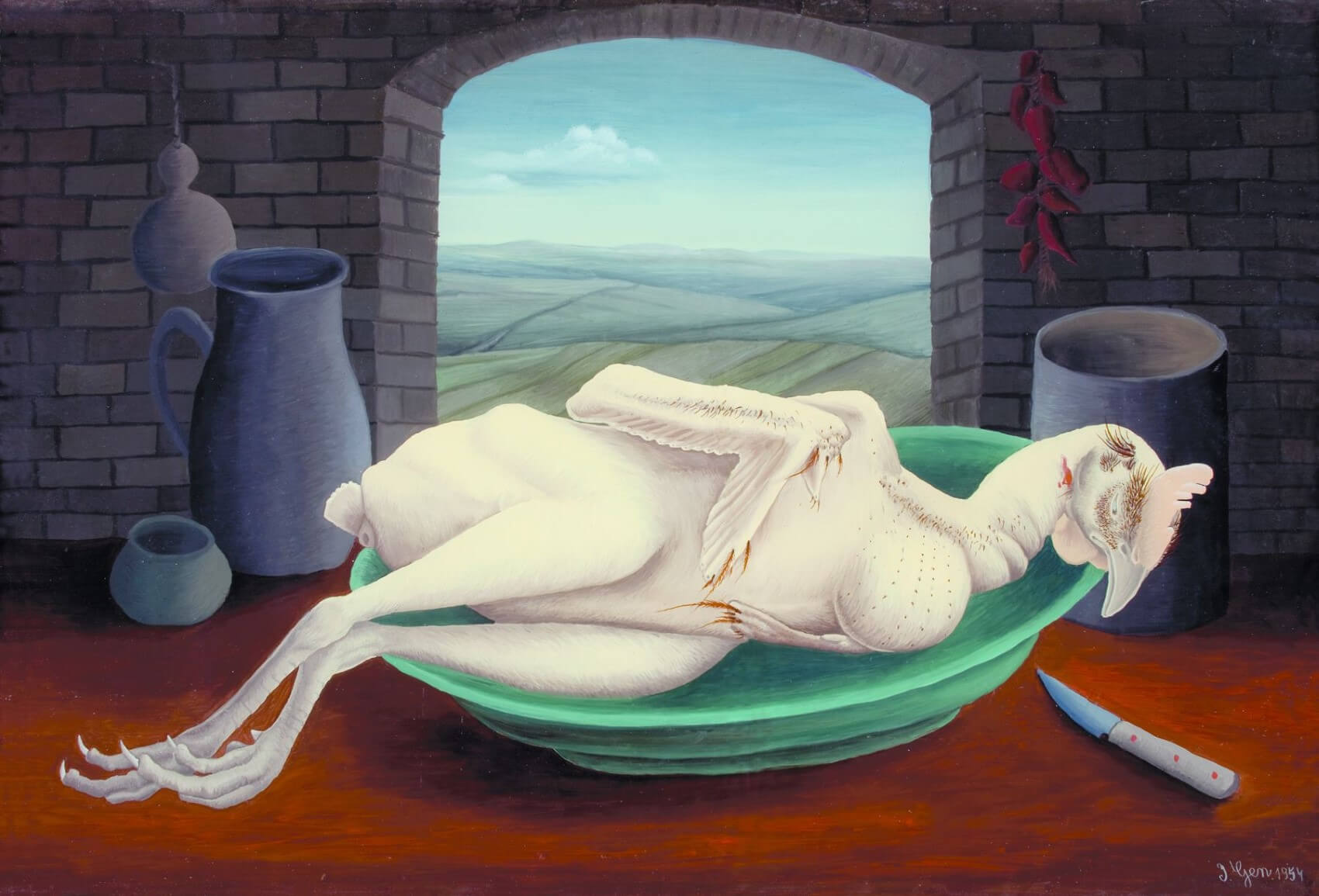 'A Battered Rooster' by Ivan Generalić, hanging at the Galerija naivne umjetnosti (Gallery of Naive Art), Hlebine © Koprivnica Town Museum
'A Battered Rooster' by Ivan Generalić, hanging at the Galerija naivne umjetnosti (Gallery of Naive Art), Hlebine © Koprivnica Town Museum
Before the end of World War I, Russia had undergone two revolutions. After the war, the German, Austro-Hungarian and Ottoman empires collapsed. Much of Europe was plunged into over half a decade of political upheaval - revolts, unrest and strikes by workers. Mostly socialist in sentiment - organised by workers and disillusioned former soldiers – this unrest and the accompanying birth of new nations lay not in the hands of the inner-city intelligentsia. And, many believed the cultural and artistic expression which reflected this new era should also come from the proletariat.
Krsto Hegedušić and the Earth Group (Grupa Zemlja)
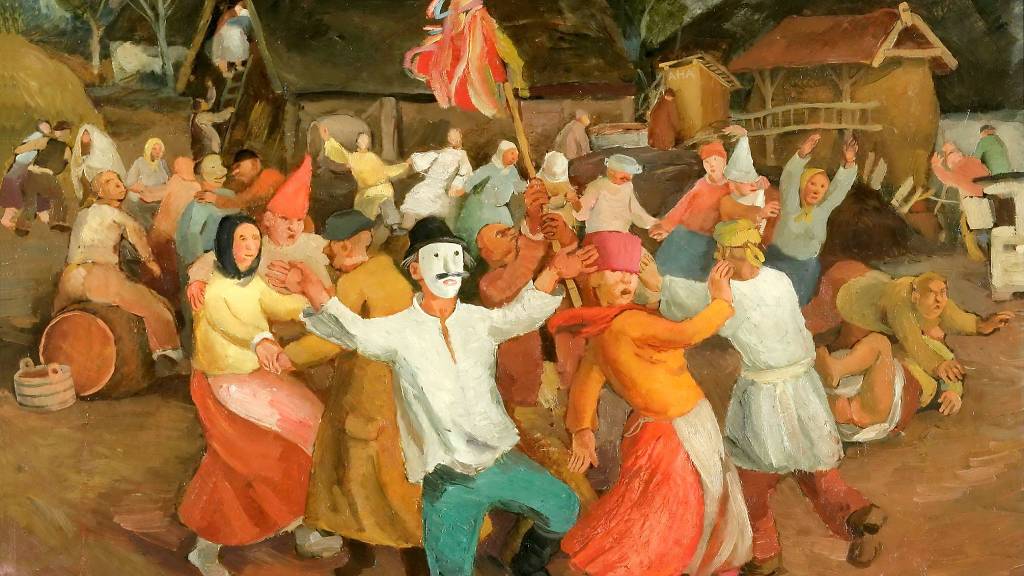 Krsto Hegedušić 'poklade' © Muzej moderne i suvremene umjetnosti Rijeka (MMSU)
Krsto Hegedušić 'poklade' © Muzej moderne i suvremene umjetnosti Rijeka (MMSU)
One Croat who believed strongly in this was painter Krsto Hegedušić. He co-founded the Earth Group in 1929 during a challenging period for Croatia. Europe was still reaping the dire economic repercussions of the First World War. Croatia had finally been freed of Austro-Hungarian hegemony, only to be forced into existing within another monarchy.
The founding beliefs of the Earth Group were that authentic artistic expression should be a product of the time and space whence it came and should be free of foreign influence. Art should not be created for the sake of art, but to depict an actual reality.
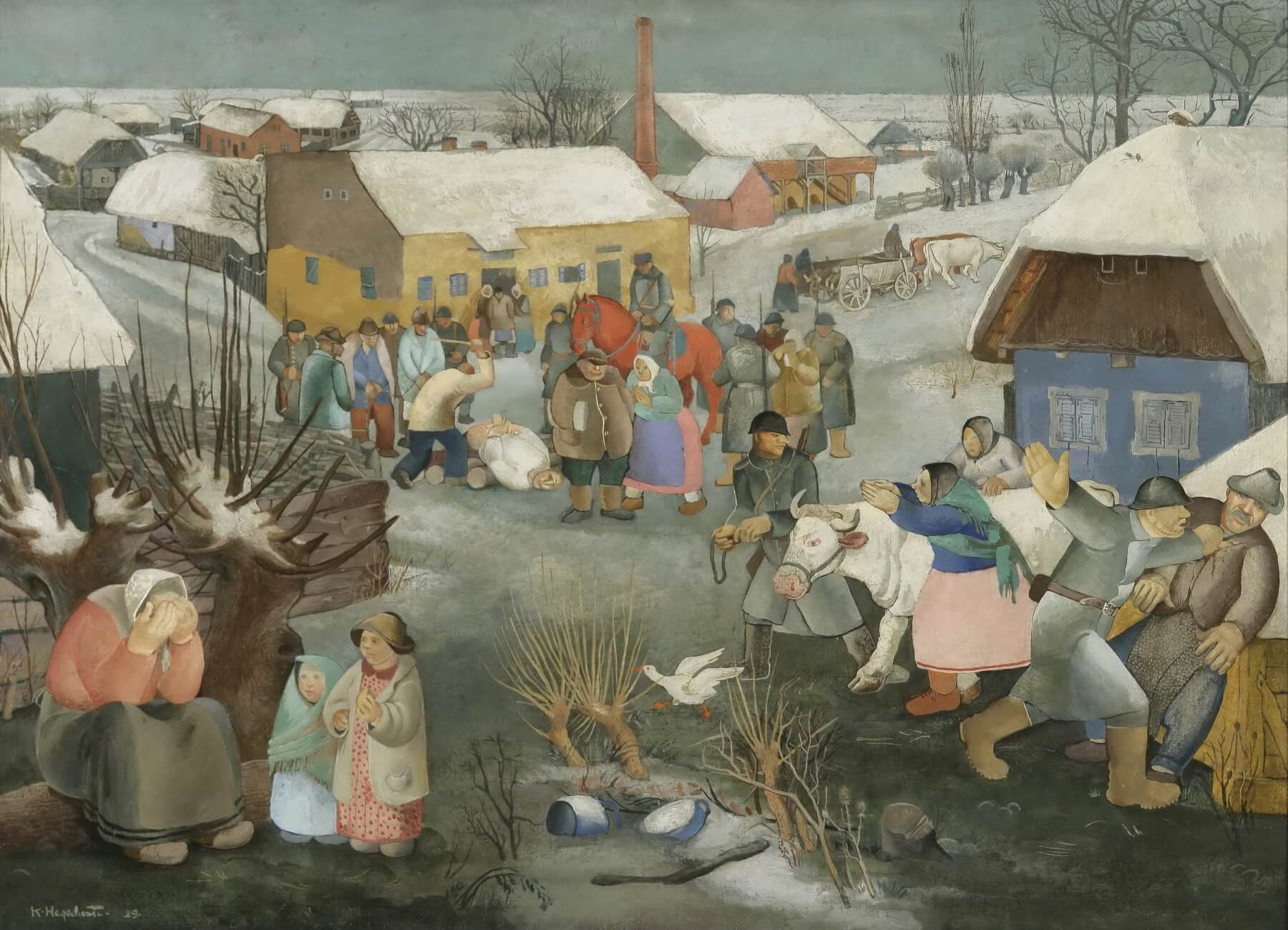 Krsto Hegedušić 'Rekvizicija (Requisition)', 1929 © Museum of Modern and Contemporary Art, Rijeka
Krsto Hegedušić 'Rekvizicija (Requisition)', 1929 © Museum of Modern and Contemporary Art, Rijeka
Krsto Hegedušić himself was very much a product of his studies. In 1920 he enrolled in what is today the Academy of Fine Arts in Zagreb. After graduating, he spent an additional two years on a scholarship in Paris. And yet, as a painter, his subject matter often reflected the world around him. Social critiques, within his work he depicted everyday poverty and the exploitation of Croatian peasants.
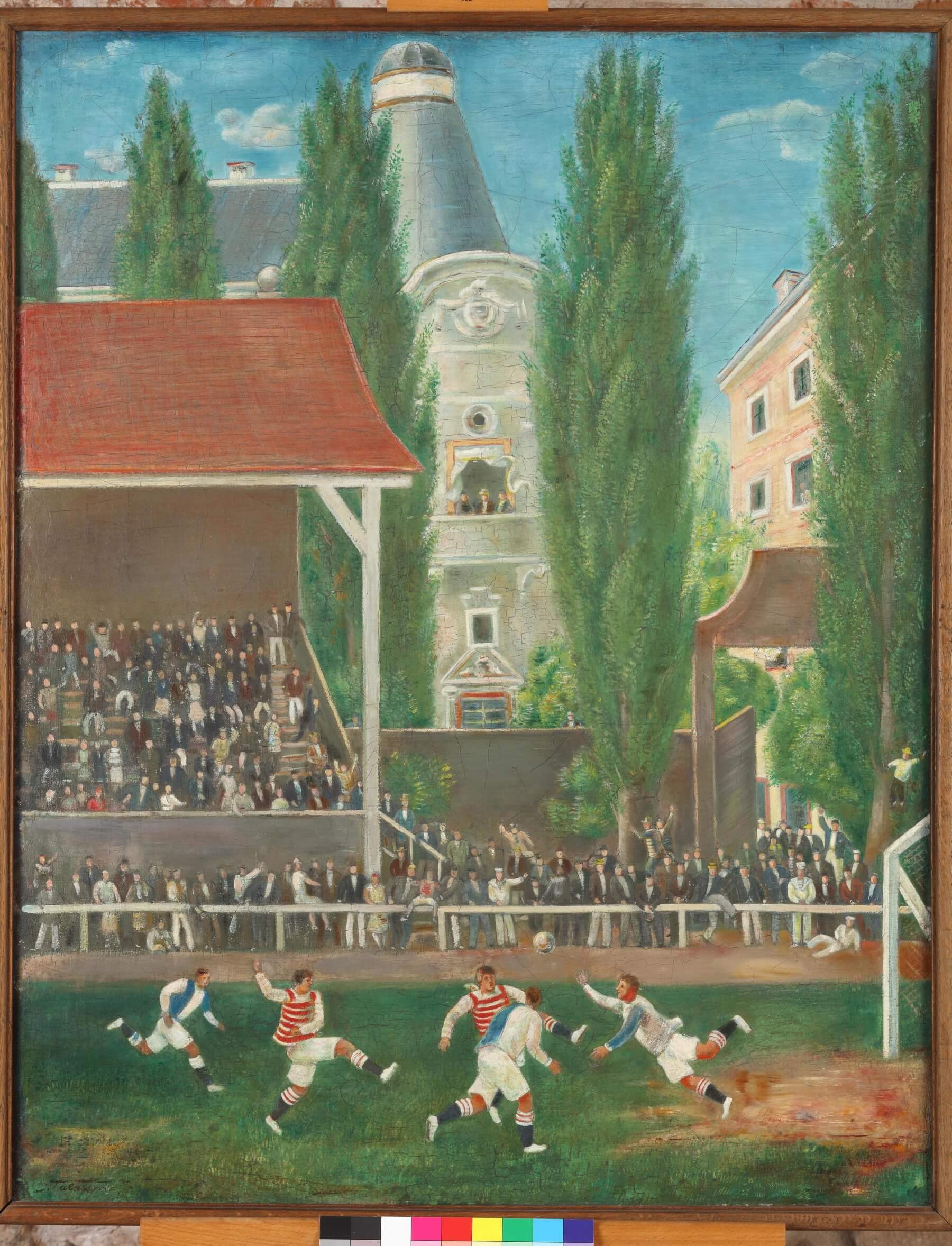 'Football match' by another of the Earth Group's founding members, Ivan Tabaković, 1927 © Gallery of Matica srpska, Novi Sad
'Football match' by another of the Earth Group's founding members, Ivan Tabaković, 1927 © Gallery of Matica srpska, Novi Sad
Born in Petrinja, Krsto Hegedušić spent summer holidays in the idyllic countryside and agricultural land surrounding his father's birth village of Hlebine, Podravina. When he was aged just 8 years old, Krsto's father died. Subsequently, the family moved to Hlebine. Later, Krsto would spend time living in Zagreb, not least for the duration of his studies. But, just one year into the life of the Earth Group, Krsto Hegedušić discovered a teenage artist back in Hlebine.
Hlebine School First Generation: Ivan Generalić, Franjo Mraz and Mirko Virius
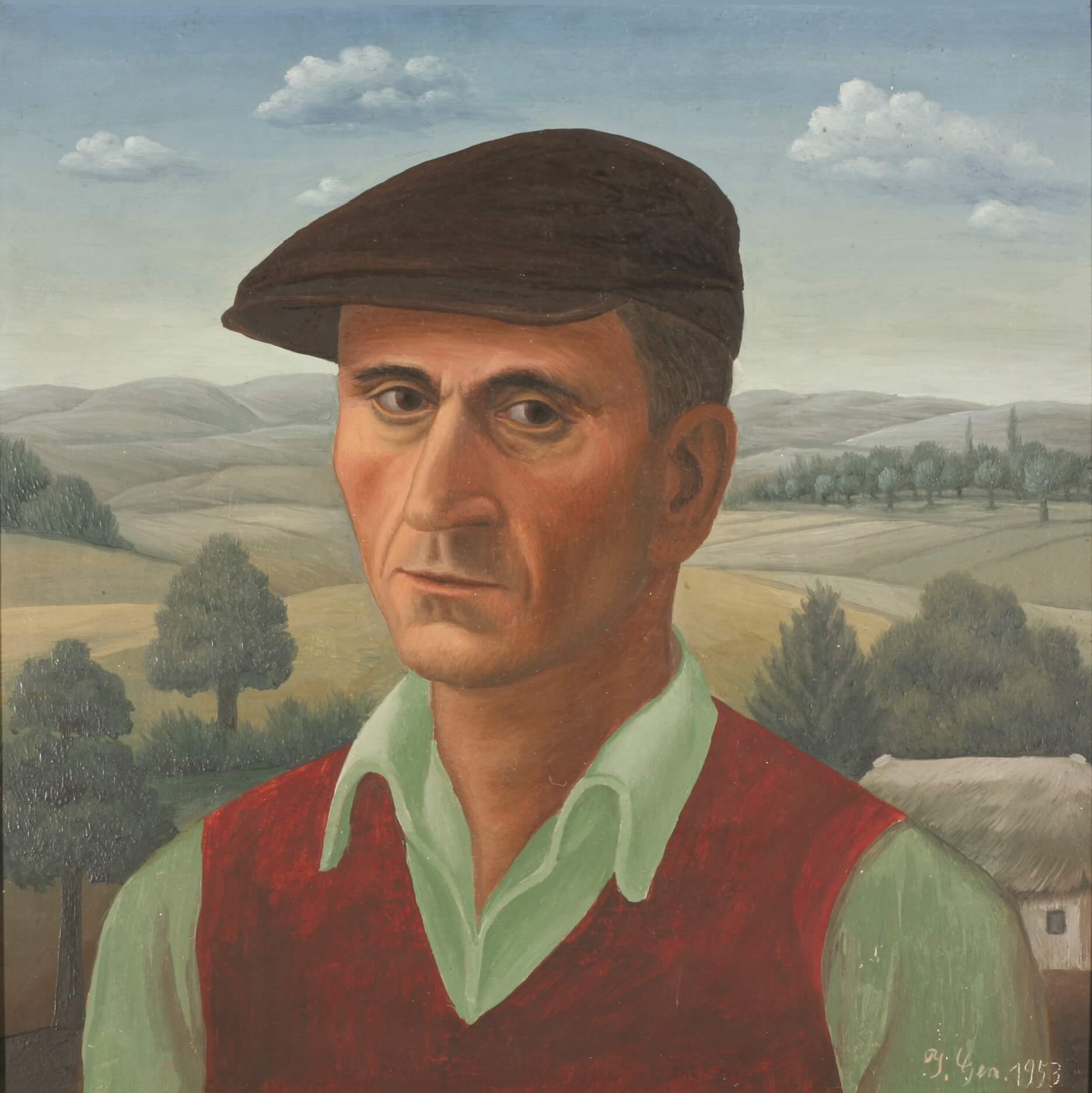 Self-portrait by Ivan Generalić, hanging at the Galerija naivne umjetnosti (Gallery of Naive Art), Hlebine. Photo © Koprivnica Town Museum
Self-portrait by Ivan Generalić, hanging at the Galerija naivne umjetnosti (Gallery of Naive Art), Hlebine. Photo © Koprivnica Town Museum
When we speak of the Hlebine School within Croatian Naive Art we are not actually talking about a building, an institution of learning. After all, the very definition of a Naive Artist is they are not classically trained. Instead, the Hlebine School is a discipline. And, more so than any Croatian Naive Art that followed, it is quite easy to define.
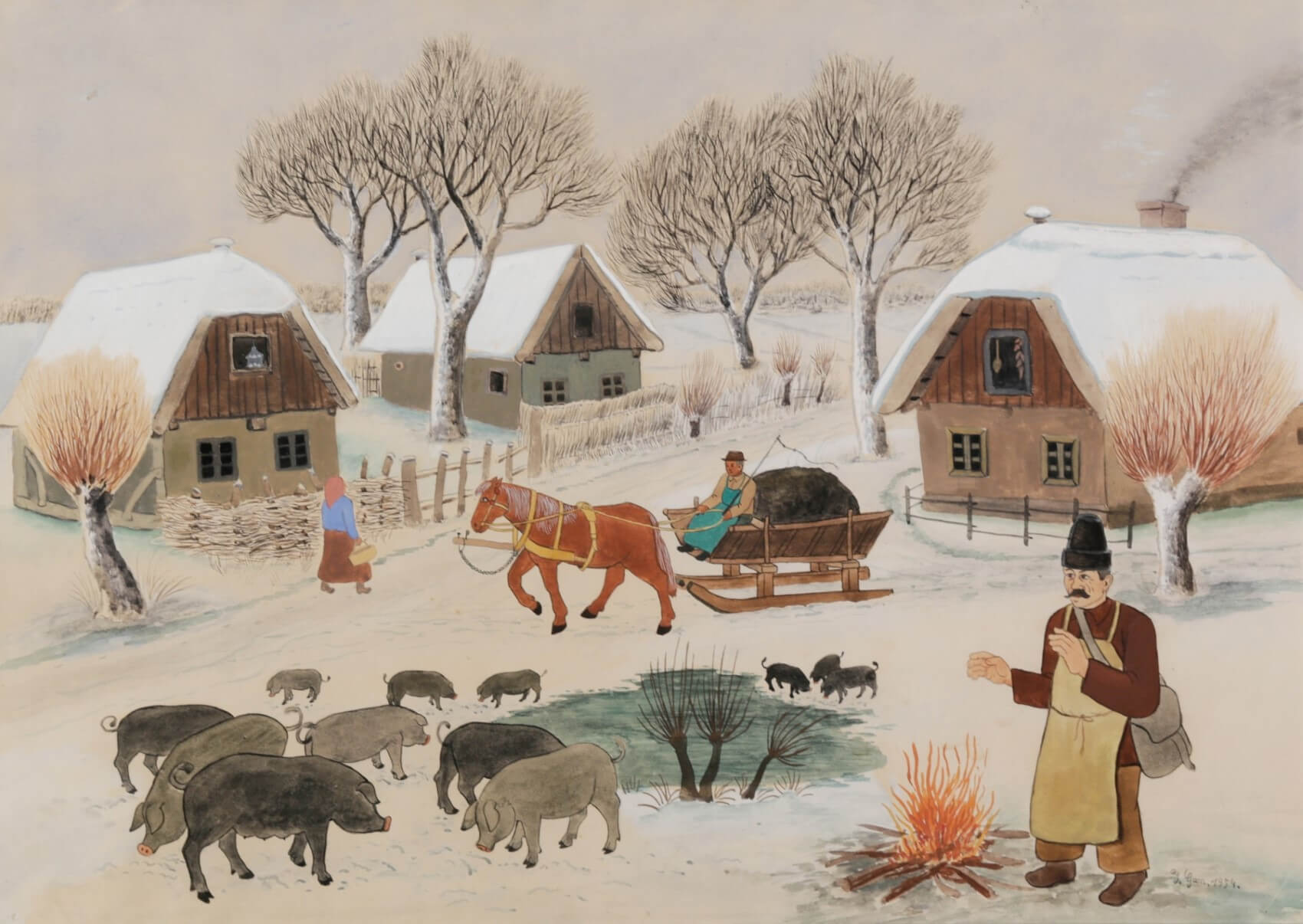 'Kanas' by Ivan Generalić, hanging at the Galerija naivne umjetnosti (Gallery of Naive Art), Hlebine © Koprivnica Town Museum
'Kanas' by Ivan Generalić, hanging at the Galerija naivne umjetnosti (Gallery of Naive Art), Hlebine © Koprivnica Town Museum
Within its first generation, the three most prominent artists are Ivan Generalić, Franjo Mraz and Mirko Virius. Both Ivan Generalić and Franjo Mraz were born, lived and were discovered by Krsto Hegedušić in the village of Hlebine. Mirko Virius was from Đelekovec, less than 15 kilometres to their north-west.
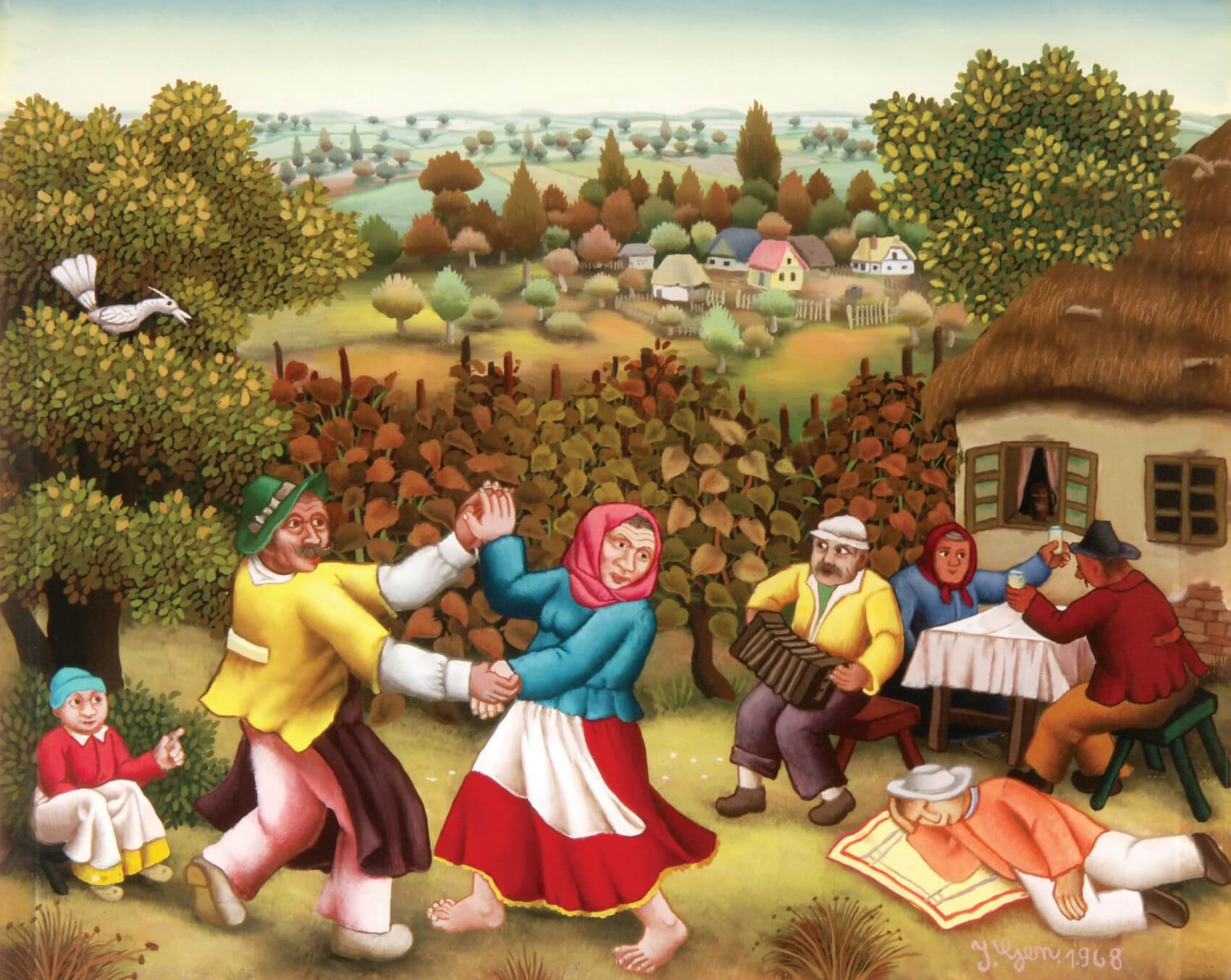 'Ples v goricaj' by Ivan Generalić, hanging at the Galerija naivne umjetnosti (Gallery of Naive Art), Hlebine © Koprivnica Town Museum
'Ples v goricaj' by Ivan Generalić, hanging at the Galerija naivne umjetnosti (Gallery of Naive Art), Hlebine © Koprivnica Town Museum
Key to identifying the Hlebine School in its First Generation is the subject matter. All three of these artists painted the world around them – their neighbours and peers, living everyday lives, in the villages, landscape and towns of today's Koprivnica-Križevci County. Certainly, Krsto Hegedušić helped inspire this subject matter, moulding the artists to suit the ethos of the Earth Group.
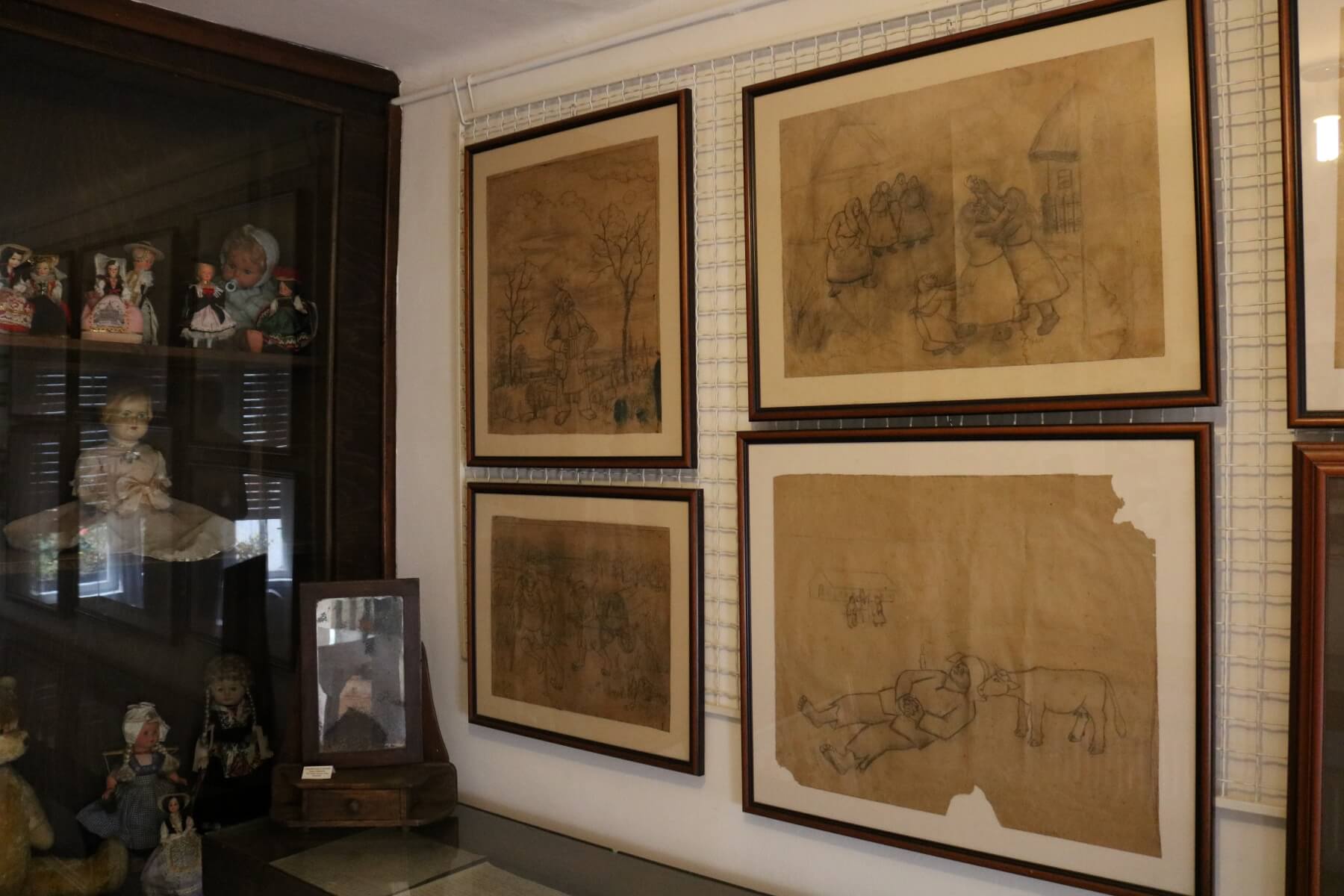
Ivan Generalić was just 16 years old when discovered by Krsto Hegedušić in 1930. The meeting would have a fast and long-lasting impact on Generalić. Ivan's humble early canvasses were the brown paper bags used in the business of a close relative. Yet, within a year of meeting Hegedušić, Ivan Generalić found his work being exhibited in Zagreb.
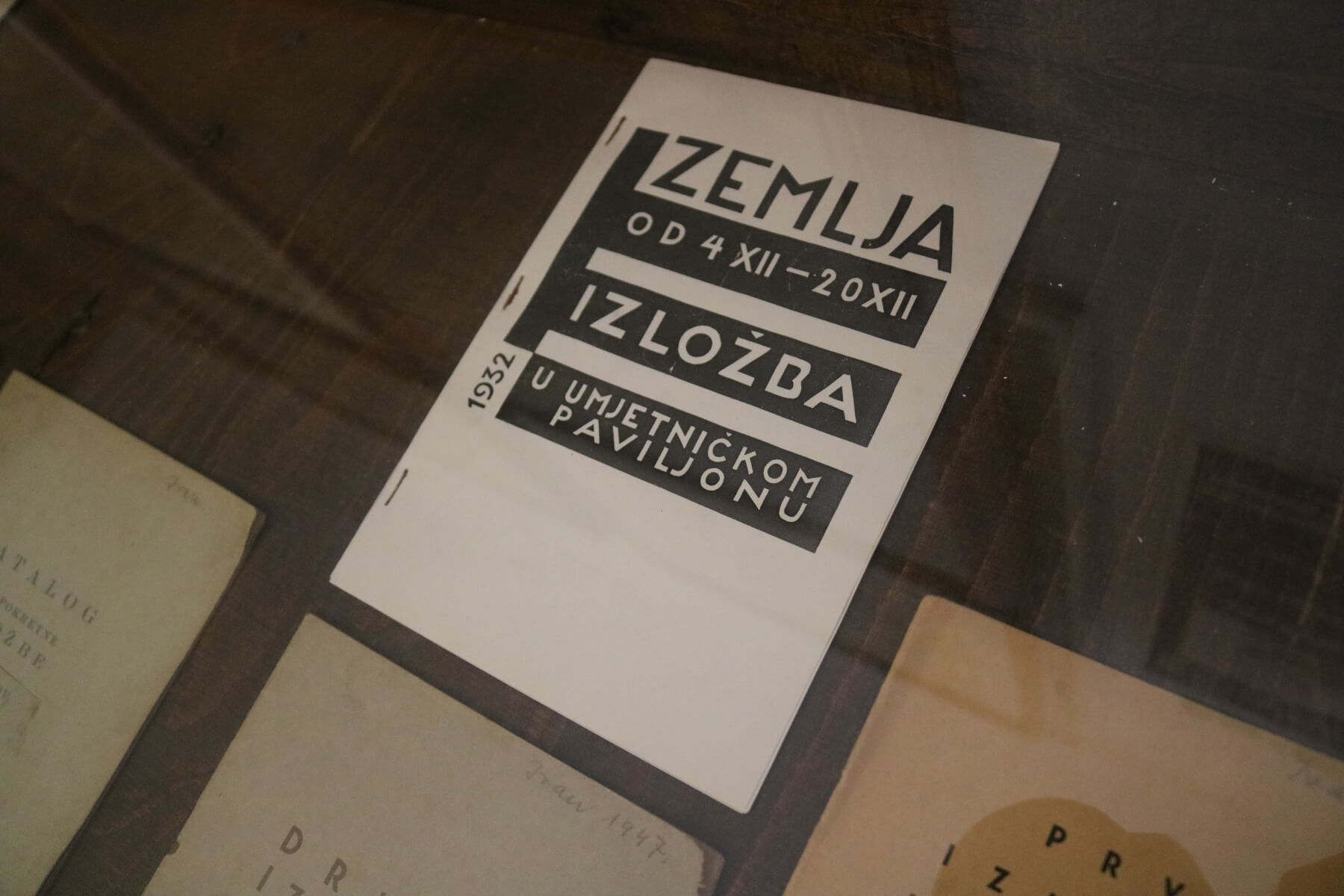
Hegedušić's shaping of the artists didn't obliterate their existing perspectives as much as it simply shifted them. For instance, Hegedušić's advice might have been "Instead of painting the church, why not paint people walking to the church in the snow?" or "Instead of marking the religious holiday by painting its origin story, why not show how you and your neighbours celebrate this holiday?"
Whether Hegedušić was conscious of doing it, or whether the artists were willfully lead, this guidance ultimately had the effect of politicising their work. In turn, this would lead the most authentic of all Croatian art into dangerous times when fascists took over the country. Proletarian in their themes, the Hlebine School and the Earth Group became viewed as Communist. The latter group was banned and Hegedušić arrested several times. During the Second World War, Mirko Virius was arrested, taken to a concentration camp in Zemun and executed. Ivan Generalić's painting of the sorrowful incident, 'The Death of Virius', is among his most famous. Franjo Mraz was also arrested during World War II but managed to escape.
 'Mask' by Ivan Generalić, hanging at the Galerija naivne umjetnosti (Gallery of Naive Art), Hlebine © Koprivnica Town Museum
'Mask' by Ivan Generalić, hanging at the Galerija naivne umjetnosti (Gallery of Naive Art), Hlebine © Koprivnica Town Museum
Aside from informing the subject matter of their work, Hegedušić also educated the painters in different techniques. One of these techniques – painting on glass – would become an enduring component of the Hlebine School and Croatian Naive Art.
Painting on glass
 'Eiffel Tower' by Ivan Generalić. The original hangs at Galerija naivne umjetnosti (Gallery of Naive Art), Hlebine © Koprivnica Town Museum
'Eiffel Tower' by Ivan Generalić. The original hangs at Galerija naivne umjetnosti (Gallery of Naive Art), Hlebine © Koprivnica Town Museum
Copying the style from imported religious art, when Hlebine School artists learned to paint on glass, it gave their efforts several distinct qualities. Firstly, if stored in the right conditions – away from damaging light – the glass protects the colours of the paint. As a result, much Hlebine School art is as brilliantly vivid today as the day it was first painted.
Secondly, this format makes the works heavy and fragile. Several masterpieces have been lost by falling to the floor and smashing.
Thirdly, painting on glass is time-consuming and challenging. Each painting must be thought out and planned in advance. The painter initially makes a sketch or preliminary painting as a guide. The image is then transferred to glass effectively in reverse. Details in the forefront of the painting must be applied first, with the background painted on top. Throughout the process, the artist will continuously check their progress on the opposite side of the glass.
Hlebine School Second Generation and onwards: Josip Generalić, Ivan Večenaj, Ivan Lacković, Mijo Kovačić, Franjo Filipović, Dragan Gaži
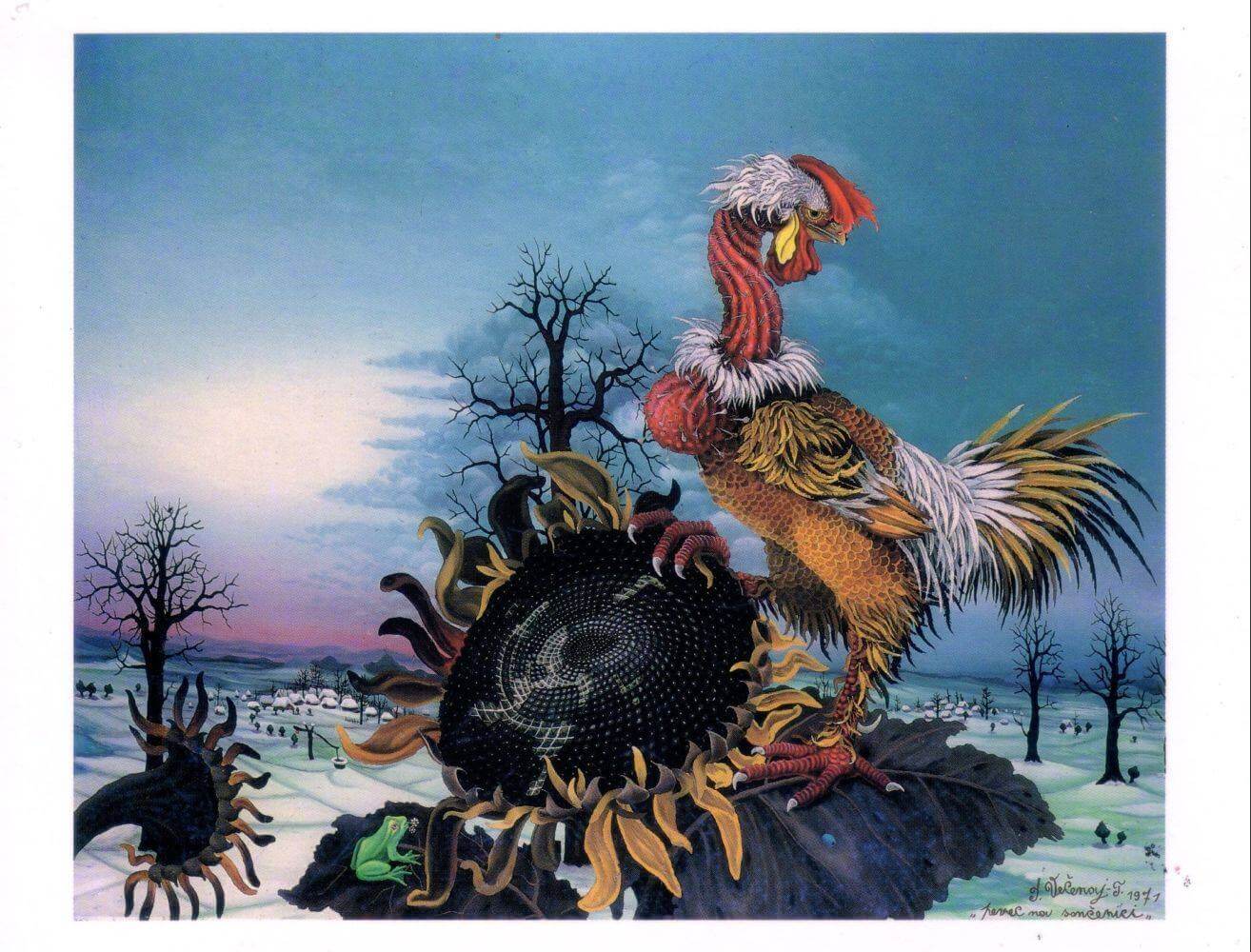 Rooster on Sunflower by Ivan Večenaj © Galerija Ivan Večenaj
Rooster on Sunflower by Ivan Večenaj © Galerija Ivan Večenaj
Perhaps to their surprise, the painters of Hlebine School first generation became a big hit. Exhibitions of their work were appreciated first in Zagreb. But, then the exhibitions began to tour across Yugoslavia and eventually the art capitals of the world. This attention would help inspire a new generation of artists from Hlebine and the surrounding area.
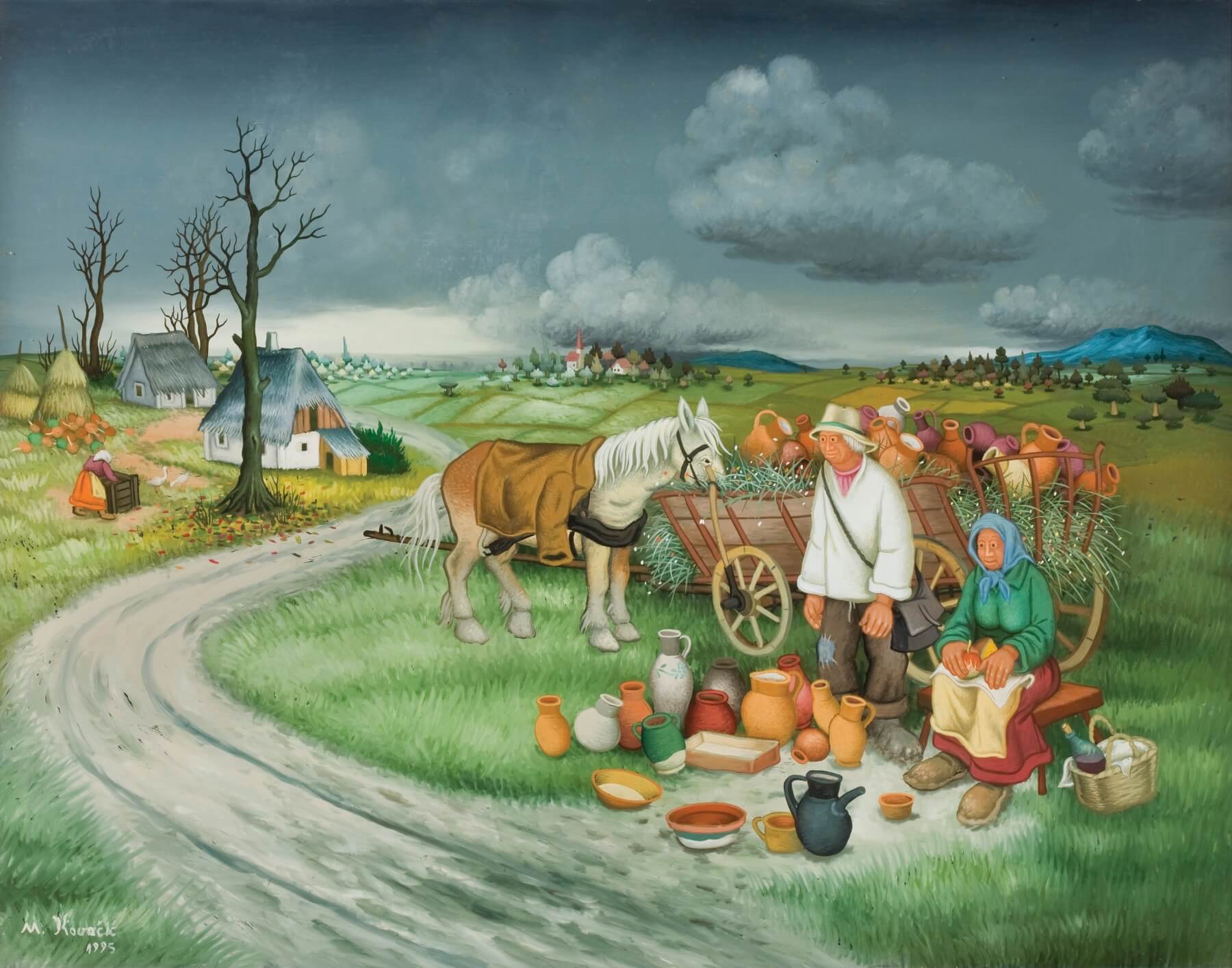 'Lončari' by Mijo Kovačić at Galerija Mijo Kovačić © Koprivnica Town Museum
'Lončari' by Mijo Kovačić at Galerija Mijo Kovačić © Koprivnica Town Museum
Success for the Hlebine School artists showed that Croatian art and self-expression were valid and valued even if unstudied. Thereafter, the tiny village of Hlebine would never look the same. More and more Naive Artists and folk artists were inspired to create. Still to this day, many continue.
While some Hlebine School artists carried on the tradition of painting on glass, others were inspired to sculpt in wood or, like Mirko Virius, paint on canvas. One of the key distinctions between later generations of the Hlebine School and the first is the subject matter.
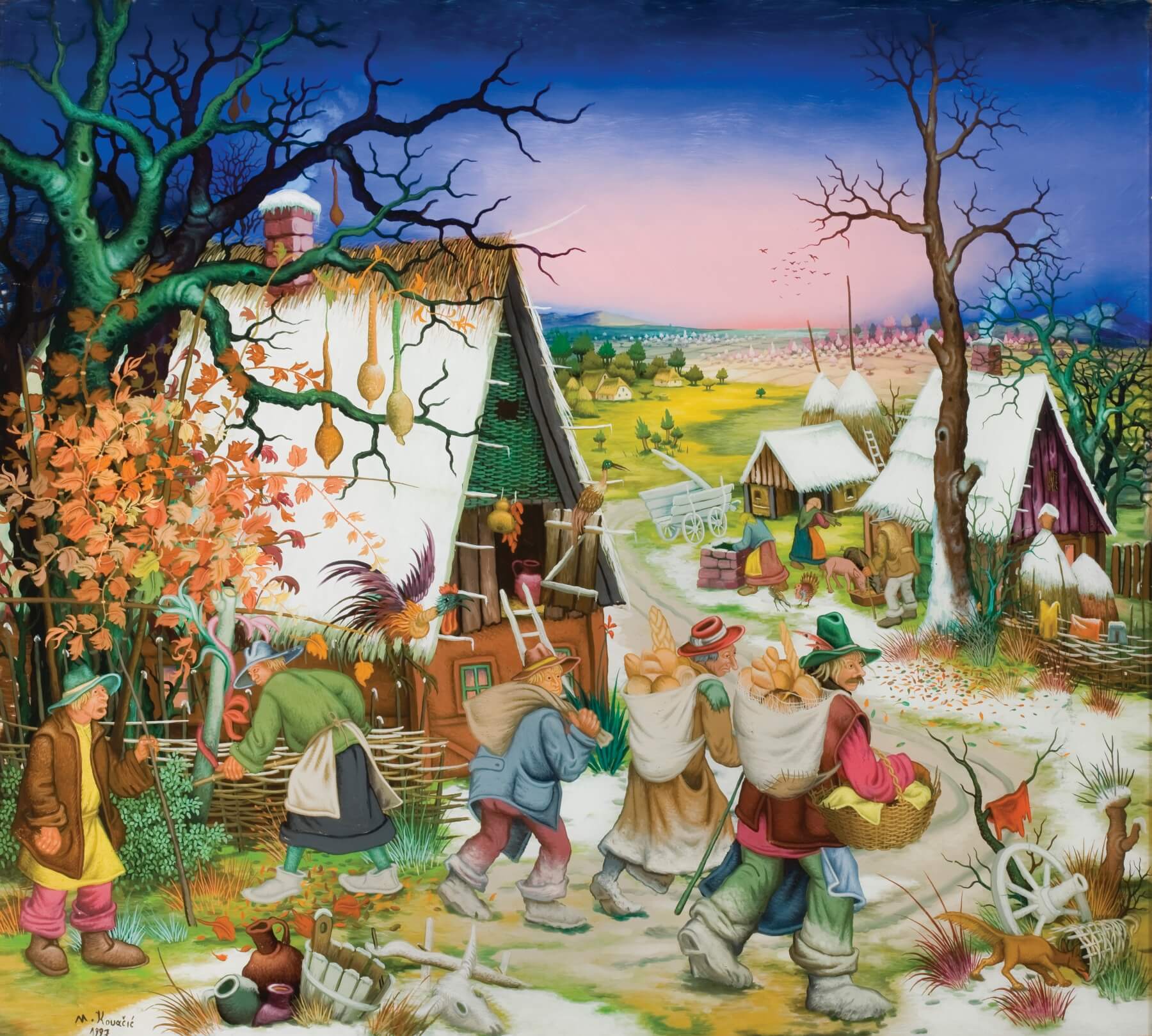 Podravina bread sellers in a picture hanging at Galerija Mijo Kovačić © Koprivnica Town Museum
Podravina bread sellers in a picture hanging at Galerija Mijo Kovačić © Koprivnica Town Museum
Second and then third generation Hlebine School artists were inspired to paint folklore, fantasy, from imagination, and with symbolic uses of vivid colur. This broadening of the style was partially the influence of Dimitrije Bašičević Mangelos, the first curator of the Gallery of Primitive Art in Zagreb (today Croatian Museum of Naïve Art). Subsequently, many of these later works would not fit within the paradigms of the Earth Group.
 'Žabe (Frogs)' by Ivan Večenaj © Galerija Ivan Večenaj
'Žabe (Frogs)' by Ivan Večenaj © Galerija Ivan Večenaj
For example, some of Ivan Večenaj's sacral paintings clearly come from the author's imagination and not his actual vision. Similarly, Josip Generalić, son of Ivan, travelled far beyond the limits of his home village in pursuit of his socio-political subject matter. Both artists were concerned with environmental issues on a global, not just a local level. Although, their work is still inextricably linked to their locale; Večenaj works the Podravina rooster emblem into many of his paintings and even depicts Christ within a Podravina landscape. So too does Josip Generalić when he paints The Beatles and others from the 60s counterculture movement.
On the Trail of the Hlebine School in Podravina & Prigorje, Home of the Treasures of Croatian Naive Art
 Locals return from mushroom picking in autumnal Podravina in a picture hanging at Galerija Mijo Kovačić © Koprivnica Town Museum
Locals return from mushroom picking in autumnal Podravina in a picture hanging at Galerija Mijo Kovačić © Koprivnica Town Museum
Some Croatian Naive Art is held in private and public collections across the world. Some of it finds a home in the National Museum of Naive Art in Zagreb. However, the vast majority of treasures from the Hlebine School of Croatian Naive Art remain in Podravina & Prigorje. The national Museum of Naive Art in Zagreb is currently closed as it undergoes the lengthy process of changing address. As a result, the following addresses in Koprivnica-Križevci County are currently the best places to see the most authentically Croatian of all the country's art.
Also, because the landscape of Hlebine, Koprivnica and wider Podravina appears in so much Hlebine School art, you genuinely need to come here to view both together. You'll get a much better understanding and appreciation of this art when you see it in its natural surroundings.
Galerija Mijo Kovačić, Koprivnica Town Museum, Koprivnica
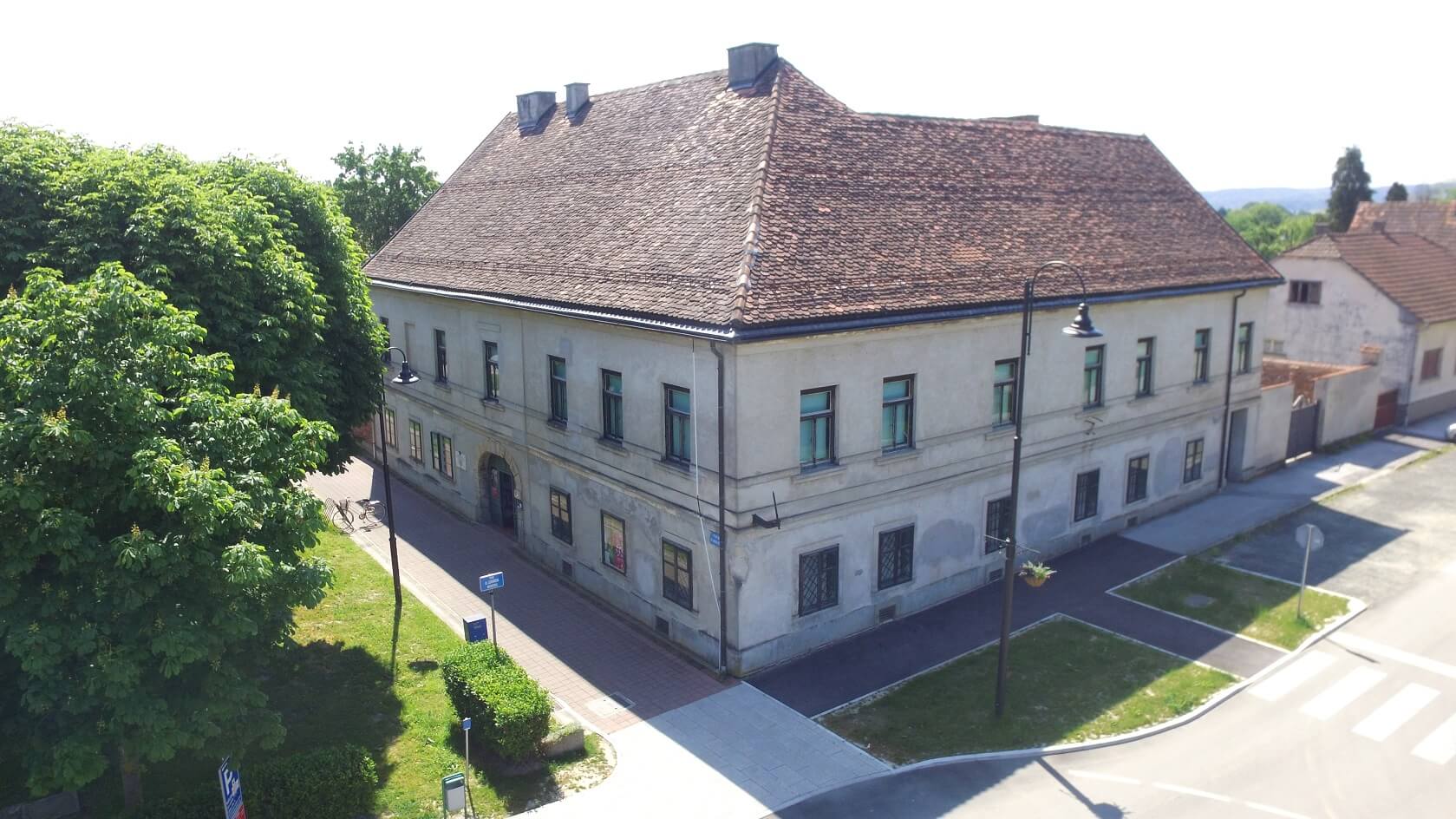 Koprivnica Town Museum © Koprivnica Town Museum
Koprivnica Town Museum © Koprivnica Town Museum
Born 5 August 1935 in Gornja Šuma, Molve, Podravina, Mijo Kovačić is one of the last remaining Croatian Naive Artists of the Hlebine School's second generation. He still paints today, albeit not quite as prolifically as in the past. He has produced such a body of work that not only can you find him exhibited in Croatian Museum of Naïve Art in Zagreb, but also in dedicated Mijo Kovačić galleries in Zagreb and Koprivnica. The one is run by Koprivnica Town Museum, which you can see above. Find out more about the gallery here.
 'Portrait' hanging at Galerija Mijo Kovačić © Koprivnica Town Museum
'Portrait' hanging at Galerija Mijo Kovačić © Koprivnica Town Museum
Galerija naivne umjetnosti (Gallery of Naive Art), Hlebine
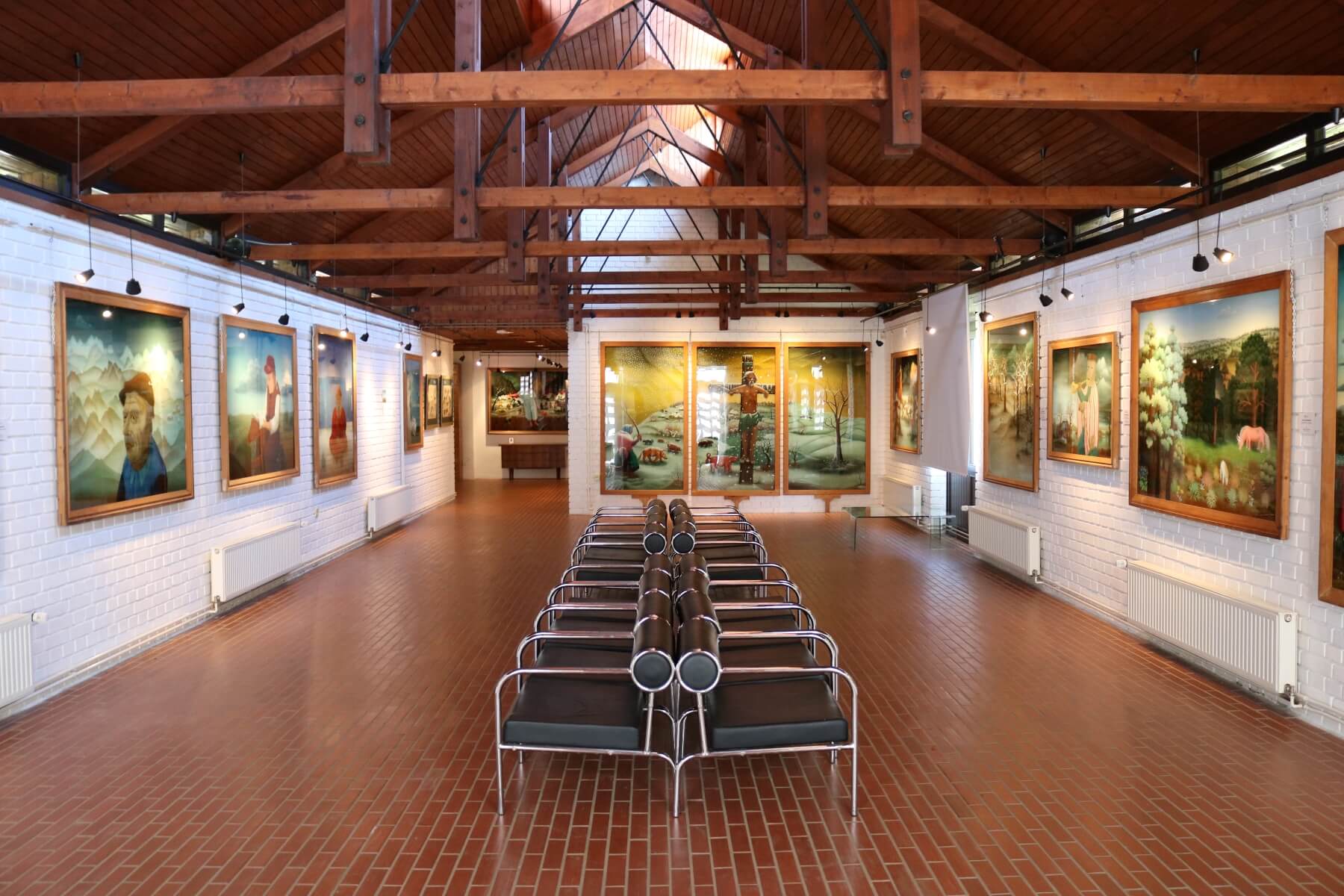
Founded in 1968, the Gallery of Naive Art in Hlebine is one of the top two most important galleries for Naïve Art in Croatia, the other being the Croatian Museum of Naïve Art in Zagreb. But, unlike their Zagreb counterpart, this gallery concentrates specifically on the Hlebine School and locally produced art. A crowd of sculpted wooden figures greets you on the front lawn. Inside, beneath the wooden beams of a beautiful building designed specifically for this purpose, some of the best artists and paintings of the Hlebine School.
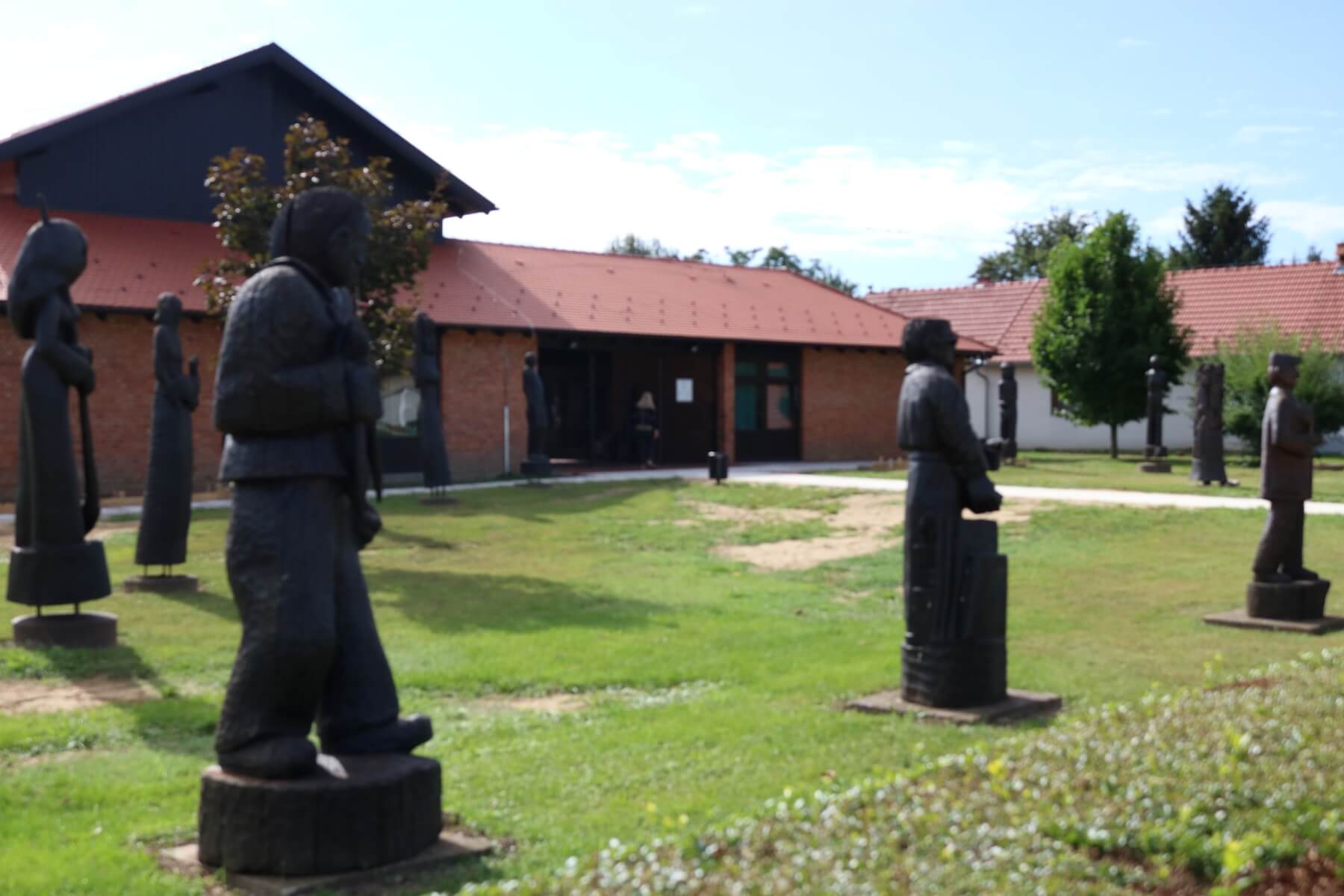
In the mid-1980s, when he was the most famous of all Croatian Naive Artists, neighbour Ivan Generalić paid the gallery a visit. He offered to pay for an extension to the gallery, on condition that it be used to house a permanent exhibition of his work. It was a win-win for the museum and Ivan Generalić subsequently donated some of his true masterpieces for the collection.
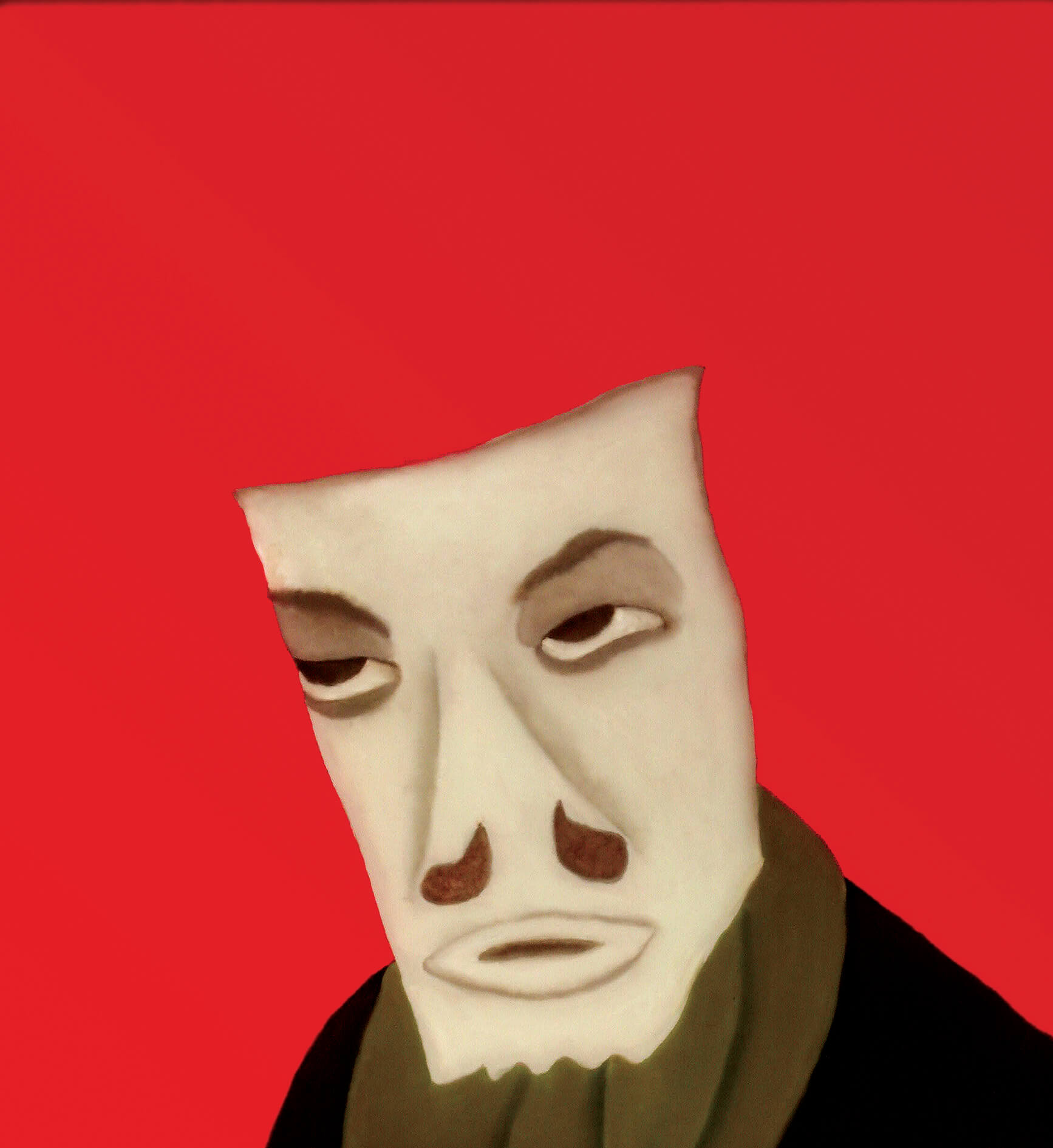
The newer part of the gallery is so true to the original design that, unless informed, you'd never guess it was built later. You'll find works by every key member of the Hlebine School here, including Ivan Generalić, Franjo Mraz and Mirko Virius, Josip Generalić, Ivan Večenaj, Ivan Lacković, Mijo Kovačić, Franjo Filipović and Dragan Gaži. Today, the museum is run by Koprivnica Town Museum. Find out more about the gallery here.
Galerija Josip Generalić, Hlebine
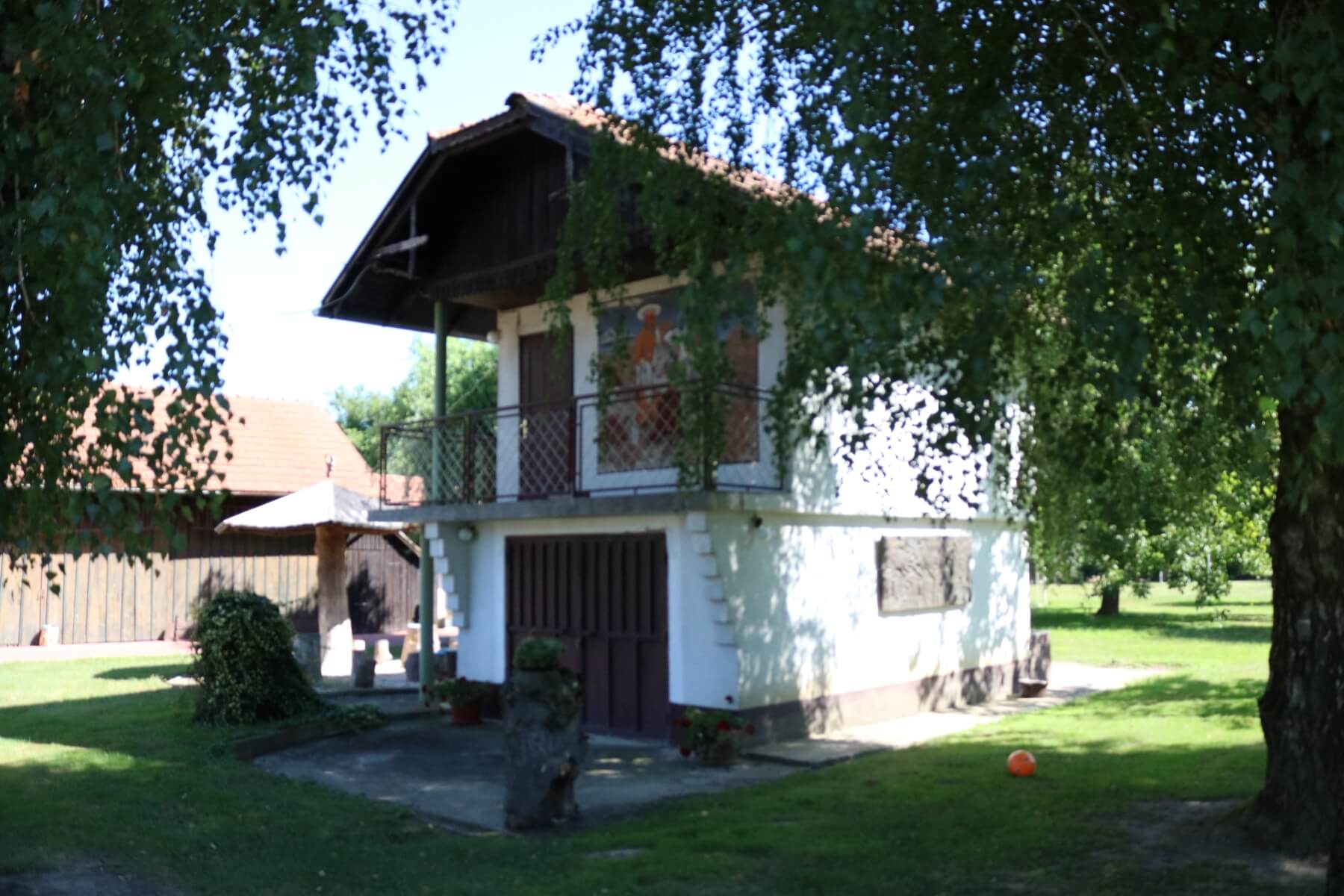
“How long have you got?” asks Ivan Generalić, grandson of Josip Generalić, great-grandson of Ivan Generalić, as he greets you at the Galerija Josip Generalić, Hlebine. He's asking if there's time for the1 hour tour or 6-hour tour. We think he's joking. He's not.
Generalić family have lived here for at least five generations. Having two of the Hlebine School's most famous and most successful painters within their ranks has allowed them to expand their property portfolio. It's just as well, because there's a lot to see here. What was once the simple, semi-agricultural farmstead where Ivan's great grandfather was born is now a sprawling family estate that houses an ethno-museum and considerable gallery spaces filled with incredible exhibits. All of the original furniture from how his great grandfather lived is preserved, displayed as it was, only in an adjoining property the family now own. Alongside the history and many works of Ivan Generalić and Josip Generalić, folk art, sculpture and artisan furniture made by incredible craftsmen from across the Balkans, who the painters once traded with.
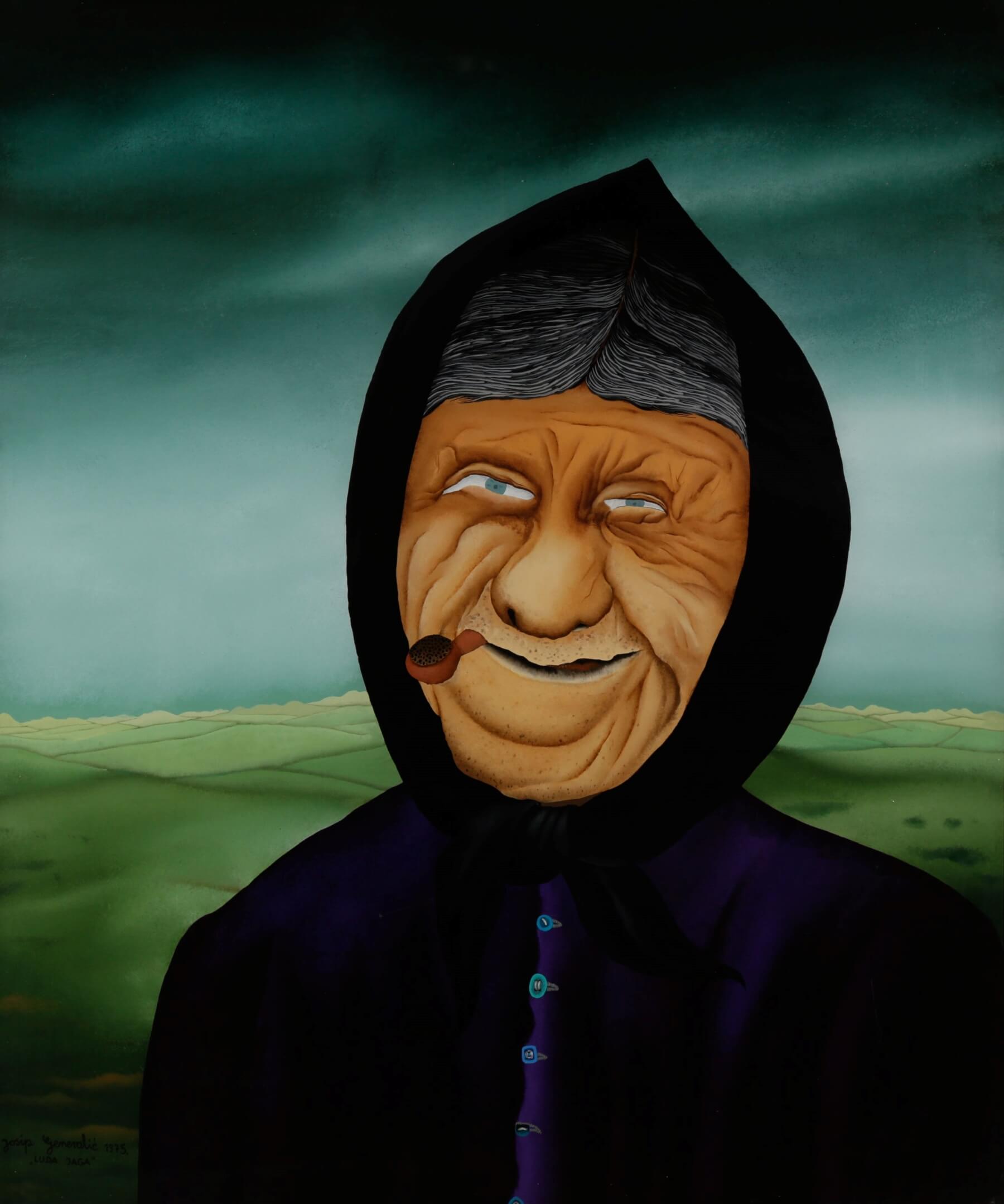 Luda Jaga by Josip Generalić, hanging at the Galerija naivne umjetnosti (Gallery of Naive Art), Hlebine © Koprivnica Town Museum
Luda Jaga by Josip Generalić, hanging at the Galerija naivne umjetnosti (Gallery of Naive Art), Hlebine © Koprivnica Town Museum
If you already like this kind of art, you might have to pinch yourself more than once that you're being shown around by someone called Ivan Generalić. Ivan himself is not only knowledgeable but extremely engaging - there are several big laughs on the tour. Ivan points out one image of an unloved neighbour, who grandfather Josip sent to the moon. He provides him with a Podravina cow so at least he can survive. Perhaps feeling slightly guilty, in the next room, Josip has painted the neighbour's return to earth. Although, he lands nearby in the famously barren Đurđevac desert (sometimes known as the Croatian Sahara). That's quite a lot of time and paint spent on someone you don't like!
Ivan's great grandfather also had a sense of humour. Having grown tired of friends bragging about their holidays in summer houses on the Croatian coast (which he did not like), at the height of his fame he decided to build his own. He invited several friends to accompany him on his holiday. And proceeded to take them to his own back garden, just metres from his main residence, where he had built the summer house. Genuinely, you'll wish you had time for the 6-hour tour. Find out more about the gallery here.
Galerija Ivan Večenaj, Gola
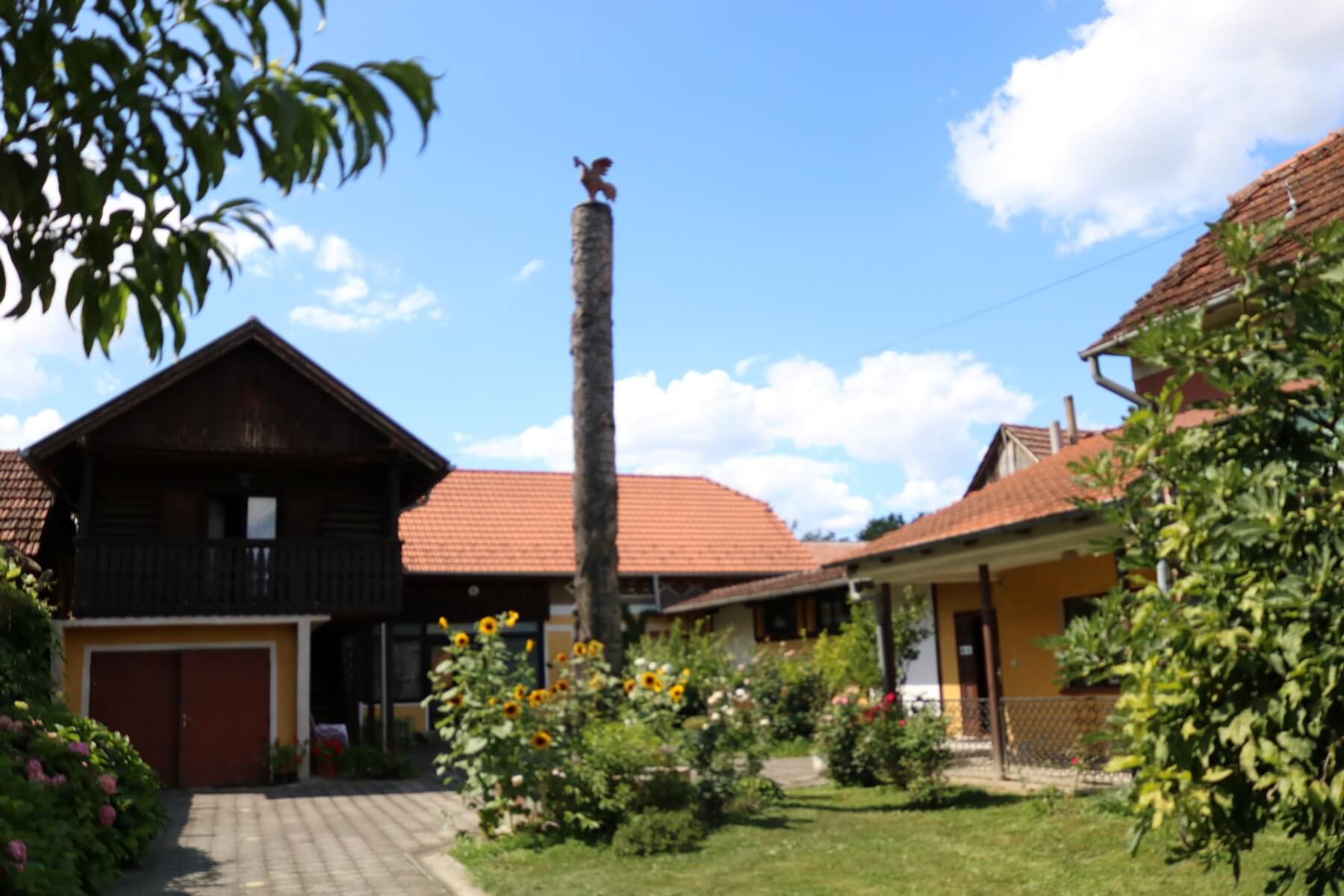
Some of the work by artists from the first and second generation of the Hlebine School are scattered far and wide. But, with the canon of Ivan Večenaj, it's a different story. Truly breathtaking examples of his finest work – definitely among the very best – were reserved by the artist for his family collection. Included in the collection, most of his key sacral works, including Golgotha, a triptych of the life of Jesus, crucifixion and the Four Horsemen of the Apocalypse. Don't worry, it's not all doom and gloom. Beautiful and bright images of Podravina roosters, agriculture and a charming portrait of his wife hang alongside. You can view them all at Večenaj's former home, now Galerija Ivan Večenaj in Gola. Across the road, an ethnic museum preserves life how it once was here. A truly unmissable highlight on the trail of Croatian Naive Art. Find out more about the gallery here.
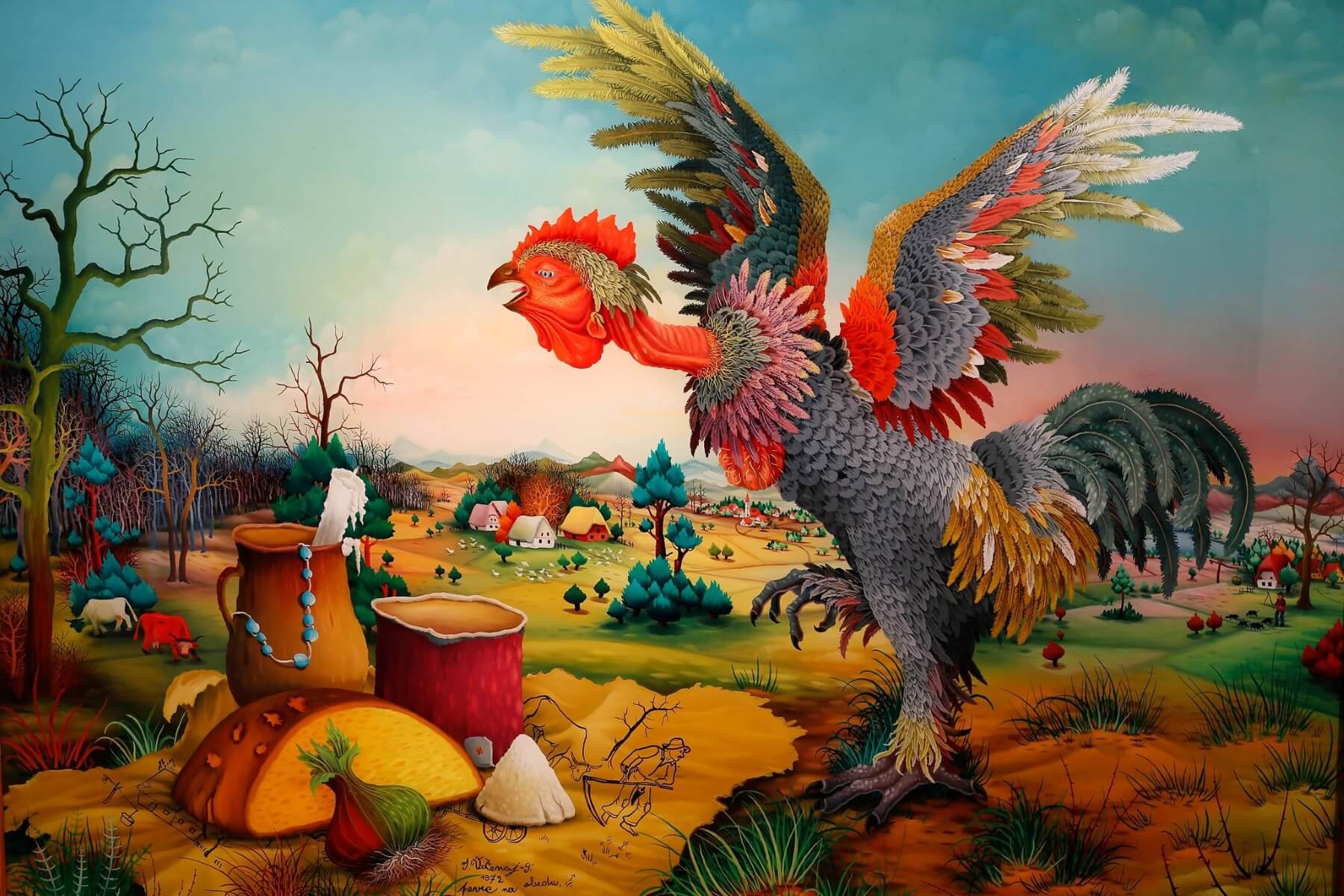 'Pevec na obedu' © Galerija Ivan Večenaj
'Pevec na obedu' © Galerija Ivan Večenaj
Galerija Ivan Lacković, Batinske
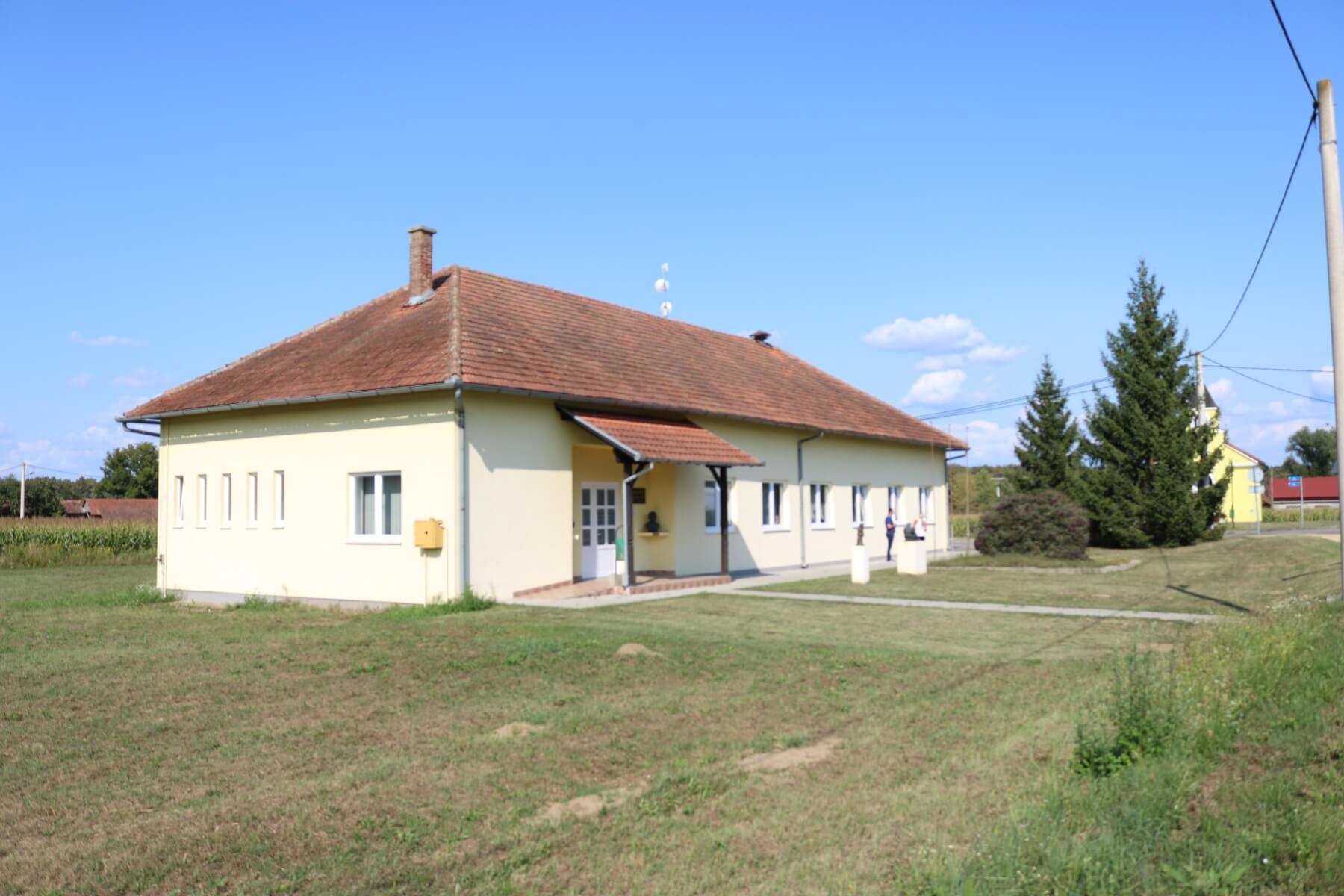
Clearly something of a local patriot, Ivan Lacković donated some 300 works to the village of his birth. Within the collection, you'll find not only works by Lacković himself but also sculptures by Naive Artists Ljubica Marulec and the painter's brother, M. Lacković. Find out more about the gallery here.

Podravina Motifs (Podravski motivi)
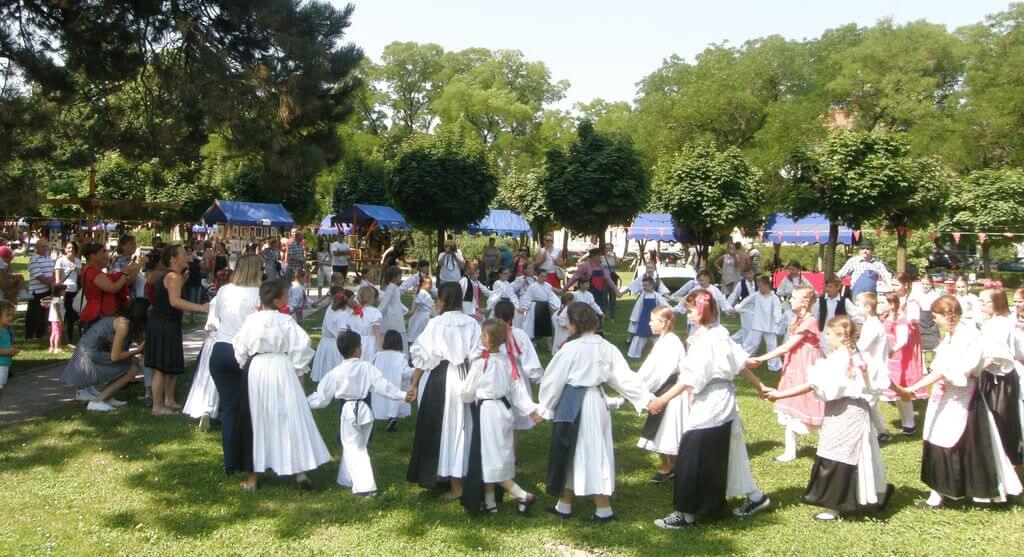 Podravina Motifs (Podravski motivi). Photo © Grad Koprivnica
Podravina Motifs (Podravski motivi). Photo © Grad Koprivnica
A three-decade-old Koprivnica event that showcases all of the cuisine, culture, music, dance, costume and art of Podravina. Naive Art is a key and central theme to the event. Usually, there are over 50 contemporary Naive Artists from the region exhibited, with their work on sale. Taking place each summer, it's a great place to get to know traditional Podravina and to pick up some amazing gifts. Find out more about the event here.
Šetnja kroz naivu u Hlebinama (Walk Through The Naive of Hlebine)
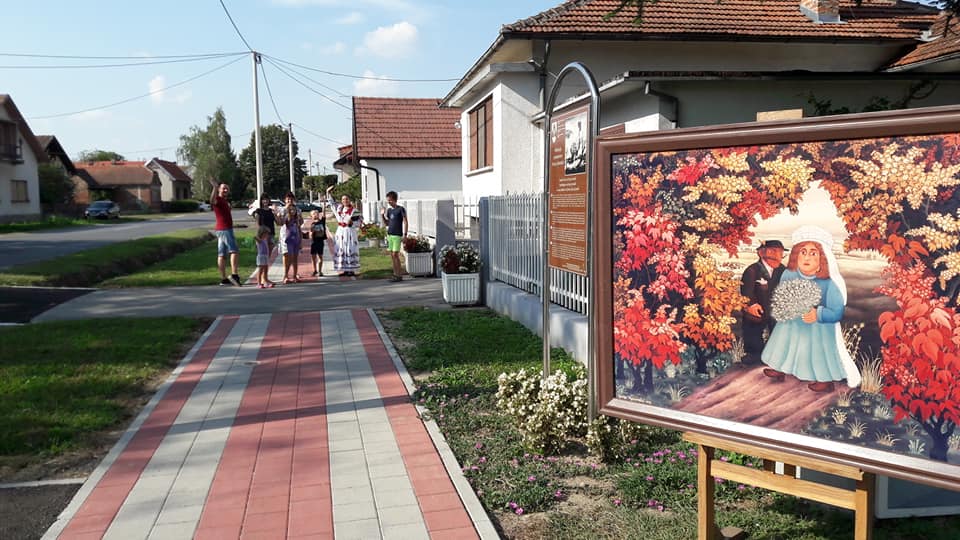 Outside Galerija Josip Generalić during Šetnja kroz naivu u Hlebinama © Tourist Board Central Podravina
Outside Galerija Josip Generalić during Šetnja kroz naivu u Hlebinama © Tourist Board Central Podravina
An annual open-air gallery of Hlebine Naive Art taking place on the streets of the village itself. Organised by Tihomir Želimorski who has the rural accommodation offer Stari zanati in Hlebine, Šetnja kroz naivu u Hlebinama differs from Podravina Motifs because it focusses exclusively on art – painting and sculpture. The houses in Hlebine are treasure troves of Croatian Naive Art. During this summertime event, all village residents bring their paintings and statues out onto the streets, hang them on trees or in gardens. You're invited to walk around the delightful village to look. Find out more about the event here.
This article was produced with the kind help of Koprivnica-Križevci County Tourist Board and checked for accuracy by Koprivnica Town Museum.
If you want to find out the latest from Podravina, be sure to check TCN pages here.
Croatian Poet Hanibal Lucić: Renaissance Genius from Hvar
August 14, 2021 - Meet Croatian poet Hanibal Lucić, one of the most respected poets from the country's renaissance period and a noble man from the island of Hvar. This is his story.
The richness of Croatia's heritage is evident not only in its many breathtaking buildings, statues and sights but also in its literature. Sadly, Croatian literature doesn't attract as much global attention as it should when compared to the global impact and various language translations that names such as Shakespeare enjoy. Not to mention antic Greek poets and writers, Italian authors such as Dante, and the list goes on.
Things are changing for iconic writers from Croatian history, such as 20th-century writer Miroslav Krleža as well as many of the modern, still active writers, thanks to the Croatian Literature site powered by the Croatian Ministry of Culture.
Prose writing doesn't have too many challenges for a professional translator when it comes to shifting the story from its original language to another, but you can be sure poetry is another story. If you read an English translation of ''The Flowers of Evil“ by Charles Baudelaire, instead of the original French version, did you really read Baudelaire or an author who made an adaptation of the poem into English in as much as was possible?
Either way, not much work done by Croatian poets is widely translated and known globally, but the Croatian poets themselves are known, and their former residences venues carrying their names and statues dedicated to them are part of the cultural offer Croatian destinations have to offer to their visitors.
In Hvar town, not too far from Veneranda, where the former church and famous former Hvar weather station lies, you can find a bust of a bearded man facing the Adriatic sea, and his eyes look as if they have that filter of lyricism, that poet-style introspect in observing the world. That should come as no surprise as the portrayed citizen of Hvar is non-other than Croatian poet, Hanibal Lucić, a nobleman from Hvar.
The exact date of his birth in 1485 isn't clear, but his date of death, December 14, 1553, is well recorded. The Croatian poet Hanibal Lucić was a renaissance poet as well as a playwright who authored the first secular Croatian drama titled ''Robinja'' (the slave woman). He served the Hvar Municipality back in the time when it was part of the Venetian Republic as a judge and a lawyer. His writings feature the Croatian Čakavski dialect (which distinctly uses the word ča for ''what''), and he wrote love poetry under the heavy influence of the legendary love poet Francesco Petrarca. Lucić was notoriously self-critical, and he even burned his work. Thankfully, his son saved his work and it was published in 1556, after his death.
Hanibal Lucić bust © Nina Lelas
In 2012, the National and University Library in Zagreb (NSK) posted an article in memory of Lucić, stating that he was the greatest writer of Croatian Renaissance poetry.
''We can gather from his literary works that he was exceptionally well-acquainted with classical literature, the Croatian Glagolitic and oral tradition, and the contemporary Italian and Croatian writing of his time. In his poetry, Lucić celebrated his love for women and for female beauty. In their aesthetic quality, Lucić’s poems represent a true masterpiece of Croatian renaissance lyric poetry. He describes beauty and love in the tradition of Petrarch, at the same time drawing on the oral tradition of Croatian love poetry,'' wrote NSK.
His poem „Jur ni Jedna na svit vila“ (No Other Nymph Upon This Earth), one of Lucić's most well-known poems, is an obligatory poem to read in the Croatian education system. You can learn more in this English version of a science paper by Tomislav Bodgan.
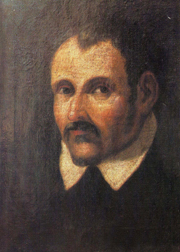
Portrait of Hanibal Lucić © National and University Library in Zagreb (NSK)
On Hvar, his summer residence still stands, and it's open to tourists to visit as its now the headquarters of the Hvar Museum.
''His summer house, the headquarters of the Hvar Museum, is a well-preserved example of the country houses of the Renaissance period, but with clear Gothic influences. Included in the museum is a reception room dedicated to the memory of Hanibal. The museum is also home to the local branch of the Croatian state archives. The opening hours are as follows: 09:00 -13:00 and 17:00 – 23:00 in summer, 10:00 – 12:00 in winter (by appointment),'' wrote Paul Bradbury for Hvar's dedicated Total Croatia page.
So, when in Hvar, do find time to visit the house but also don't forget to visit his bust and seek one of his pick-up lines that can help your banter with that pretty girl on the beach.
Learn more about Hvar on our TC page.
For more about Croatian history, follow TCN's dedicated page.
AEPO-ARTIS: Croatia Making Position of Performing Artists Difficult
ZAGREB, 3 Aug, 2021 - AEPO-ARTIS, a non-profit organisation that represents over 650 performing artists, has sent a letter to the Croatian culture minister criticising Croatia for being late with the adoption of new copyright legislation and missing a deadline for the implementation of two EU directives, the Croatian Musicians Union said on Tuesday.
The organisation said that the implementation of the Copyright Directive and the Directive on online transmissions and retransmissions was being delayed because Croatia was late with the adoption of the new Copyright and Related Rights Act.
The letter, signed by AEPO-ARTIS secretary general Ioan Kaes, says that the COVID-19 pandemic has widened the gap between the growth of profit by online giants and individual artists because the latter do not participate in the fair distribution of this turnover.
The situation is particularly dramatic because in the new business circumstances the turnover of online platforms has become a dominant source of income for the music industry. For over a year and a half, performing artists have been denied their basic source of income - live performances, while at the same time the use and turnover of their recordings increased and performers could not enjoy their rights equally with others. Although their works still reach wide online audiences, artists receive small or no remuneration for them, according to the letter.
The institute of performers' inalienable right to remuneration is not incorporated into the proposal for the new Copyright and Related Rights Act, and under the proposal, record companies would be given an additional three years to adjust their business. This would allow Croatian record companies to continue their unfair and unethical practice of blackmailing performing artists and not paying them for the performances that have been used by online services for years, the letter said.
AEPO-ARTIS concluded by saying that introducing the inalienable right to remuneration, which artists would be able to exercise through their collective management organisations, is the best, if not the only, solution that guarantees that artists receive appropriate and proportionate remuneration for their work.
For more about politics in Croatia, follow TCN's dedicated page.
Brick Yard: Part Exhibition, Part Party, Complete Post-Lockdown Artistic Showcase
June 29, 2021 - A unique event for the Croatian art scene, Brick yard, a meeting point between an exhibition and a party, features four Croatian artists presenting their work and making a statement that not even coronavirus can stop art.
EDITOR'S NOTE: The event was moved to July 3, due to a bad weather forecast
The coronavirus pandemic and the experience of lockdown were either an inspiration for artists or those circumstances just made it easier for them to focus on their work as everything was closed and isolated. Much like almost everything else, the art and culture sector wasn't immune to the pandemic's heavy blow.
With art events and exhibitions still facing challenges, Jasmina Krajačić, Mario Romoda, Apolonija Lučić, and Zorana Unković, instead of waiting for the support by the culture ministry or for galleries to return to being fully functioning institutions, took their faith in their own hands.
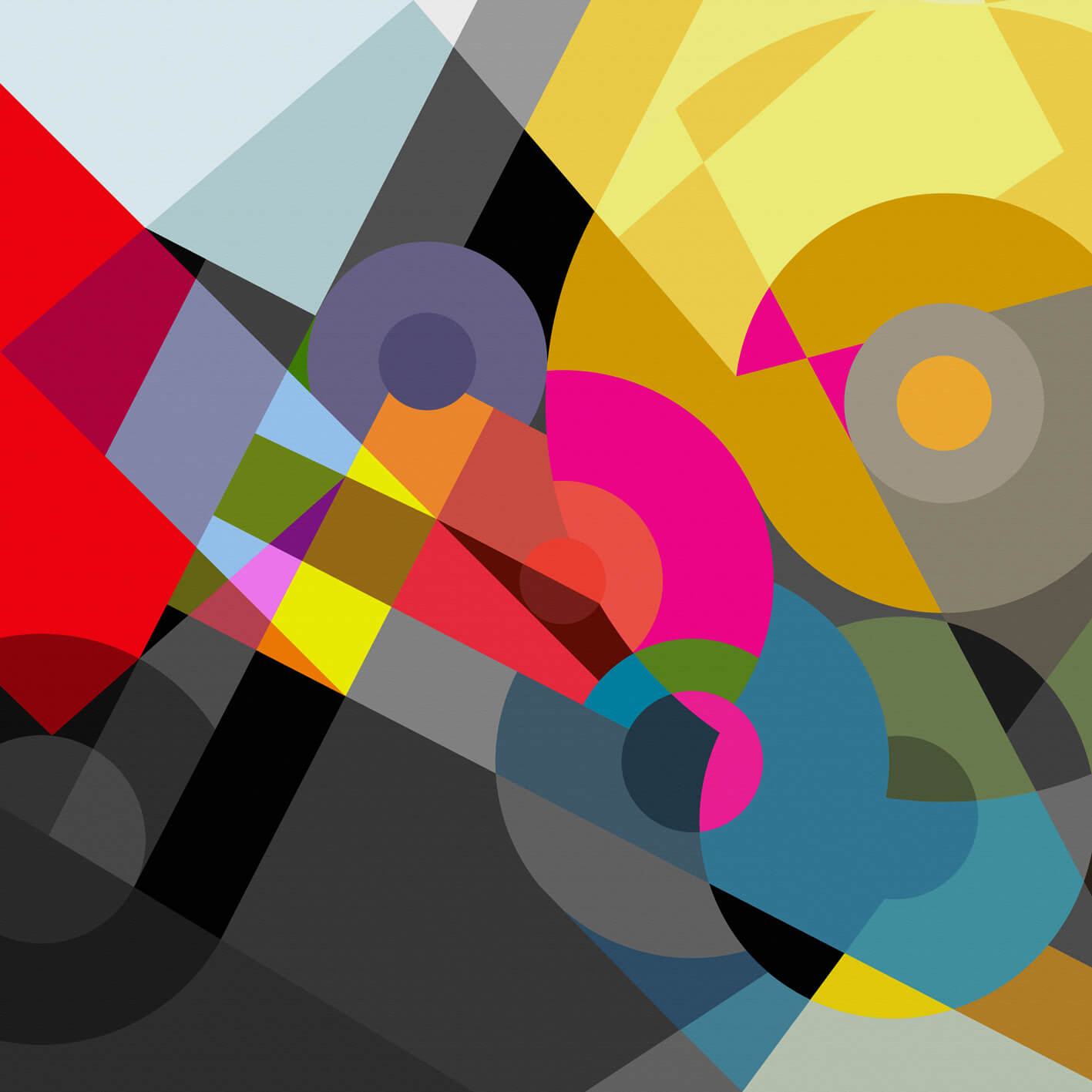
© Jasmina Krajačić
Their initiative for cultural growth, titled Brick Yard, will see these artists present their work in a garden located in Lomnička 1, in a beautiful garden that truly looks like a piece of art itself. Observing art like a plant that, in order to grow, needs to be watered constantly, the collective will showcase their work on July 1 from 5-9 pm.
''The four of us have studios at the same address. It's an old house with quite unusual dimensions and a big garden hiding the view from bypassers. That garden looks like it fell from mars, and it doesn't fit in with the series of new buildings recently built in the neighbourhood, and not a lot of people know about it,'' explained Krajačić, stating that this is the true charm of this project.
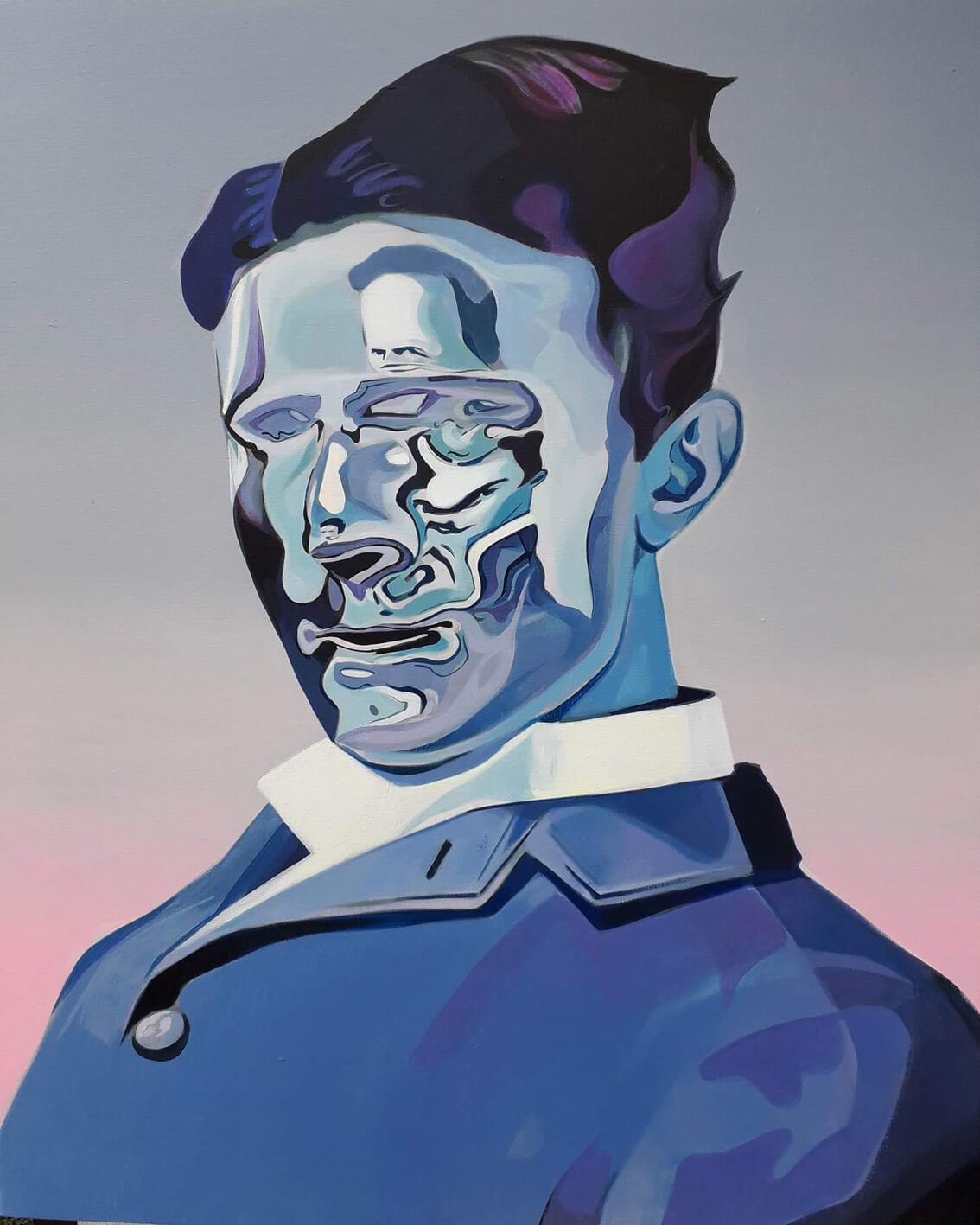
© Mario Romoda
All four artists are renowned names in the world of Croatian contemporary art, and it's interesting to observe different takes on the artistic expressions they have. Romoda is into painting, Krajačić's main focus is geometry and design, Lučić navigates toward drawing and illustrations while Unković is skilled in street art. Echo, reflection, self-therapy, comic strips, and geometry are some of the aspects artists pointed out Brick Yard will feature.
''Since the start of the lockdown, we hung out and worked in that space, killing some time in uncertainty, waiting for the outcome of this whole situation, while also creating new work with our creativity and discipline, which we decided to present in the garden,'' continued Krajačić.
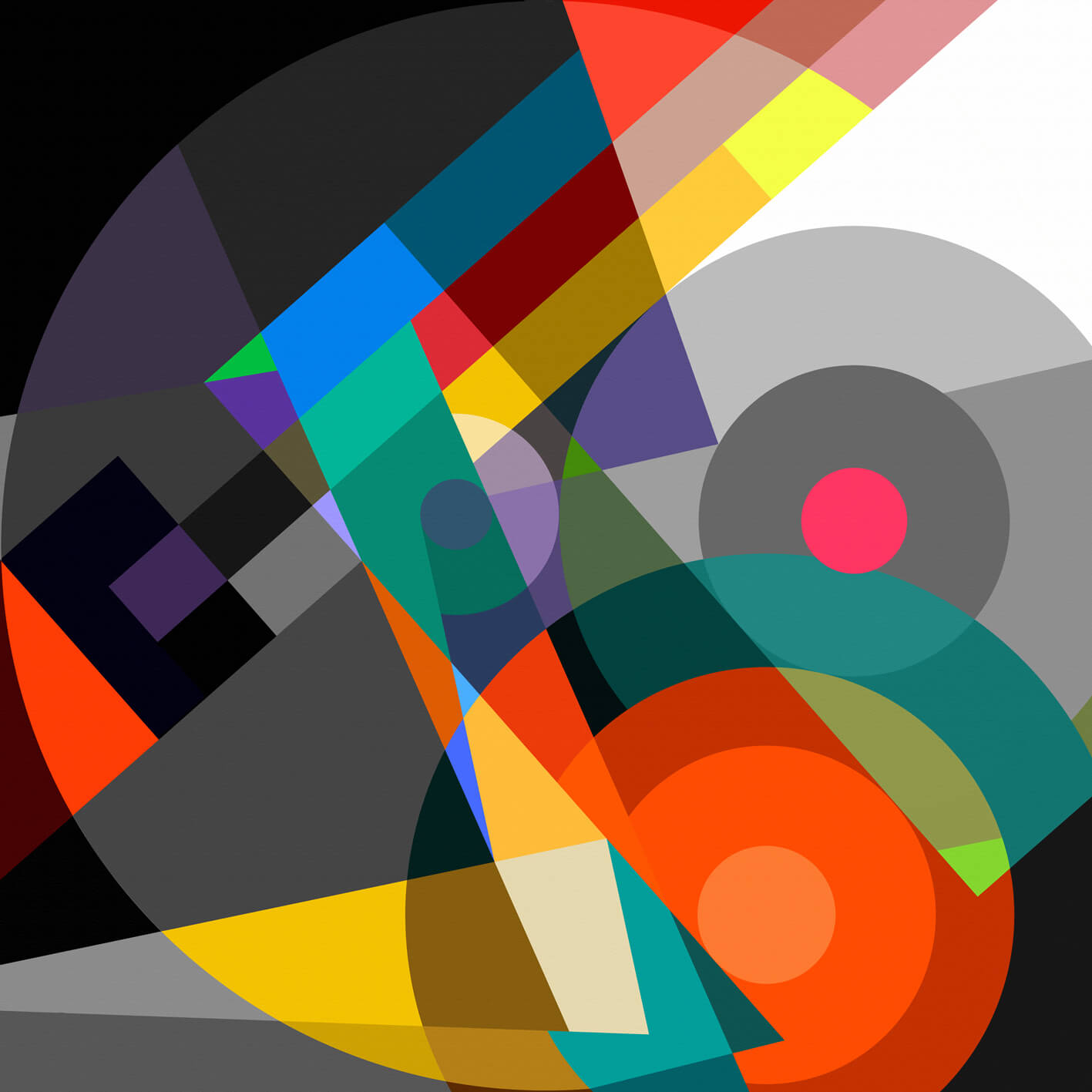
© Jasmina Krajačić
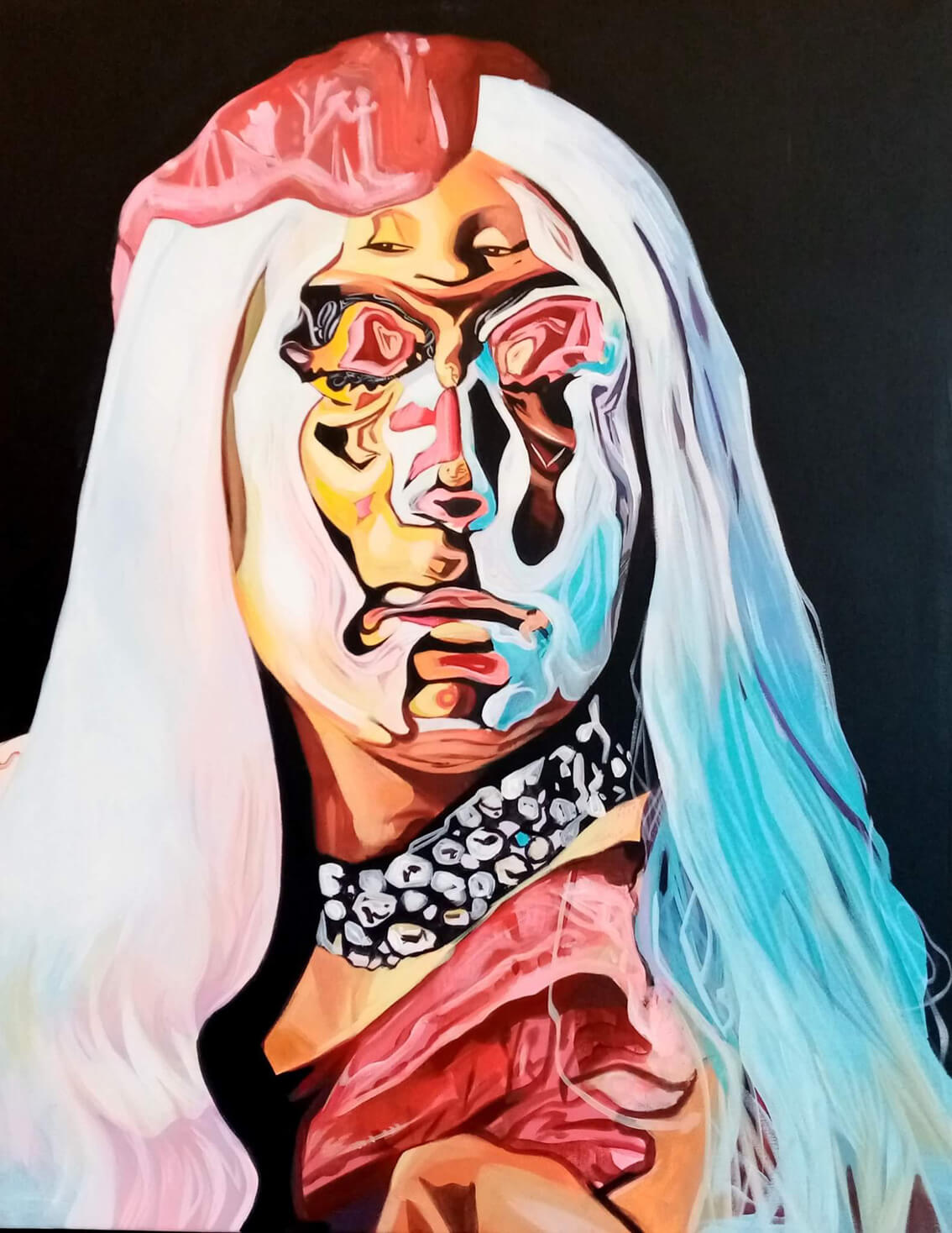
© Mario Romoda
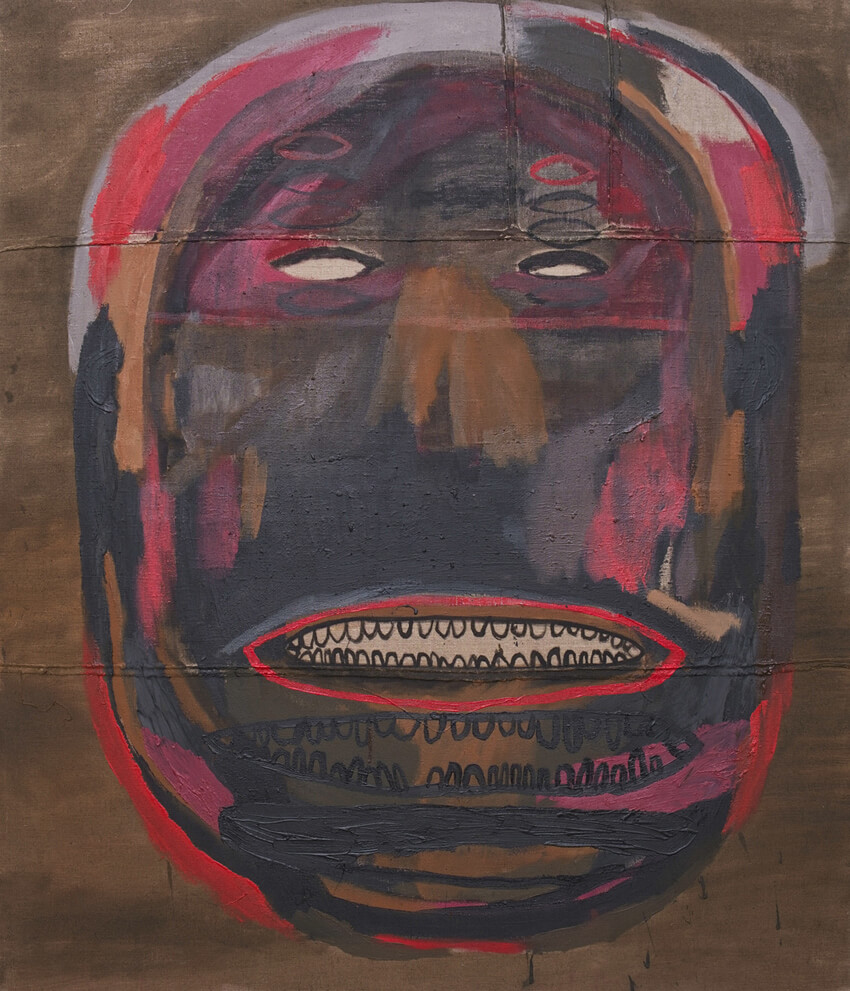
© Zorana Unković
The event, which lay somewhere between an exhibition and a party, saw the artists invite business associates, gallery workers, art critics, and several friends in the hope of ensuring the support the Croatian art scene desperately needs.
''We invited them for an afternoon in an unconventional environment, without big talks and classic gallery protocols,'' pointed out Krajačić, concluding that this type of event is not typical at all on the Croatian art scene. This unusual, experimental event is just as art should be, and the message that the Brick Yard collective differs in expression and stands united in their message is loud and clear.
''Art cannot be stopped as it feeds every atom which thirsty for creative progress. Without it, we're fragile and empty,'' they concluded from Brick Yard.
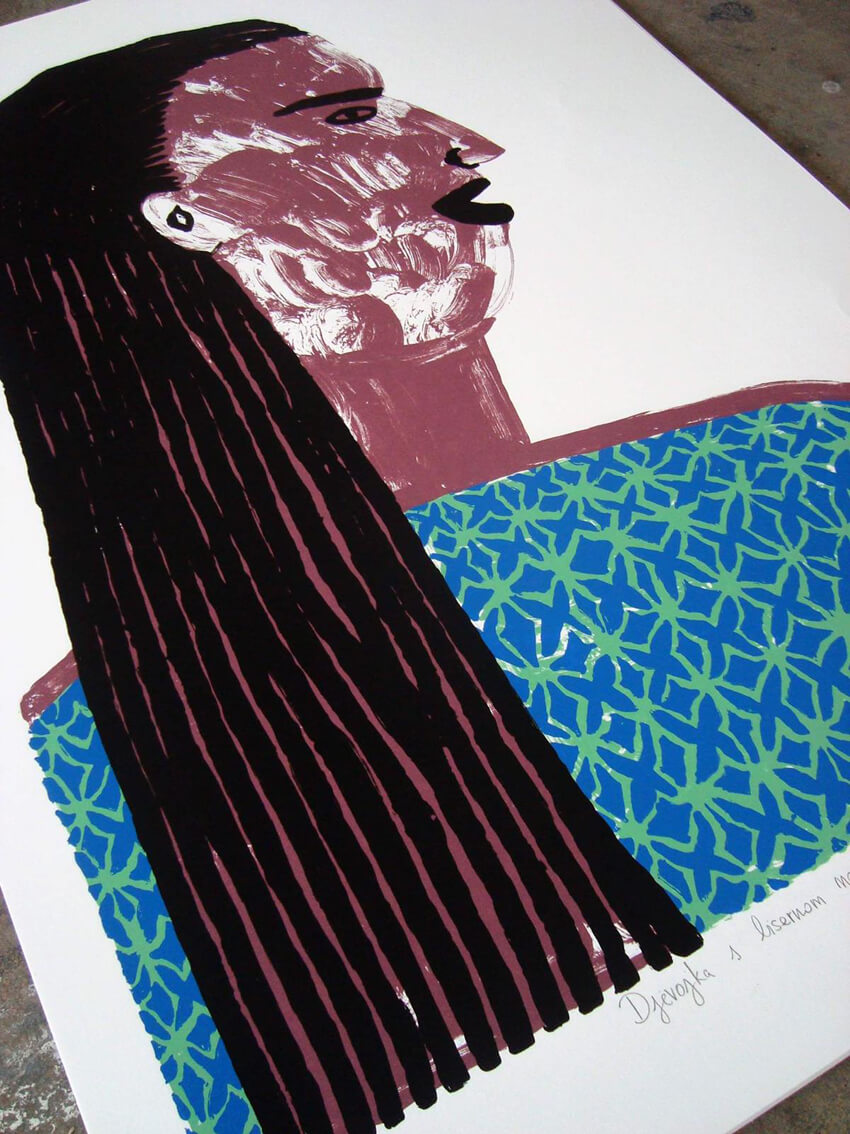
© Apolonija Lučić

© Zorana Unković
Learn more about Croatian Art Galleries in Zagreb, Dalmatia, Istria & Slavonia on our TC page.
For more about art in Croatia, follow TCN's dedicated page
Professor Slavko Krajcar Death: A Look at the Life of Fantastic FER Professor
June 24, 2021 - Following the professor Slavko Krajcar Death on June 18, take a look at the life of an established educator and scientist whose expertise made a significant contribution to Croatian politics in the energy sector.
„The influence of a teacher can never be erased“, or as an American historian Henry Brook Adams put it, „Teachers affect eternity; no one can tell where their influence stops“- these two are just some of the inspirational quotes about teachers you can find with a little assistance from Google.
Students at the Faculty of Electrical Engineering and Computing (FER) at the University of Zagreb are recognized in Croatia for their innovations. At the end of the day, they owe their excellence to the professors that educated them.
One of such professors was Dr. Slavko Krajcar that sadly, as FER official website reported, passed away on June 18, last week.
"Professor, Dr. Slavko Kranjcar made a significant contribution to the Faculty of Electrical Engineering and Computing as he was a dean of the Faculty from 1998-2002, after which he was the head of the department for high voltage and energetics from 2002-2006. He will remain in permanent memory as a respected scientist, expert, and a colleague“, said FER in an official release.
Kranjcar was also the member and the president of the Managing council at Ruđer Bošković Institute (IRB) that also expressed its condolences.
Born on January 14, 1951, Slavko Krajcar enrolled to study in FER in 1969, followed by graduating from Technical High School in Pula. He majored in FER in 1980 and got his Ph.D. in 1988. His scientific and lecture career started in 1974 when he was an assistant on a manufacturing electric energy course. From there on, he mentored various students on different levels, ten of which earned Ph.D. statuses under his guidance.
Kranjcar was active in the media, giving interviews and writing op-pieces on education issues, specifically the education of engineers in the 21st century.
„Krajcar participated on many domestic projects regarding science or economy as well on international scientific and professional projects. Counting just after the year 2000, he participated in over fifty projects, 36 of which he led. He was one of the leading figures in making Croatian Energetic Strategy (which the parliament accepted in 2010) and the Energetic Efficiency Strategy (2008) as well as executive plans on new strategies (2008-2020)“, recalled FER.
They added Fer rewarded Krajcar in 2002 when he received Josip Lončar's golden plaque for his dedicated scientific and educational work. He also received special recognition for developing SRCE- The Computer Centre of the University of Zagreb in 2011, followed by the Ho CIRED award for contribution in developing the field of electro distribution in Croatia. He also received HRO CIGRE recognition in 2018 for the overall contribution to the electro energetic activities in the Republic of Croatia and the Nikola Tesla Award in 2020 for the contribution to science, education, and profession in the field of electrical engineering and computer sciences and application of those technologies.
Believe it or not, Krajcar even made time to contribute to art and culture as well. He published two books of poetry, edited four books regarding cultural issues, and was the president of the Association for Čakavski dialect (distinct for the use of Ča as a word for what and conversated on coastal Croatia).
Learn more about Croatian inventions & discoveries: from Tesla to Rimac on our TC page.
For more about science in Croatia, follow TCN's dedicated page.


